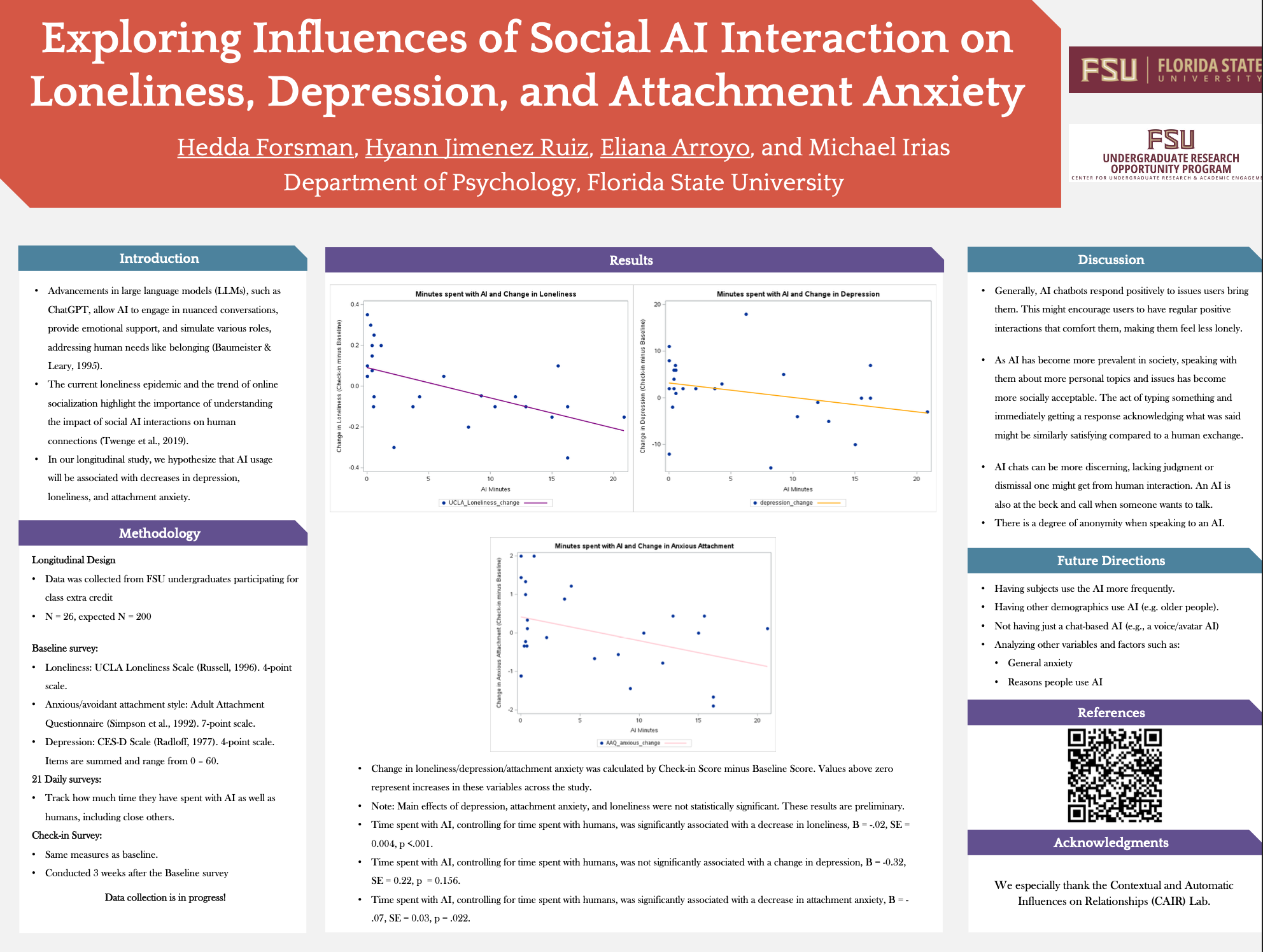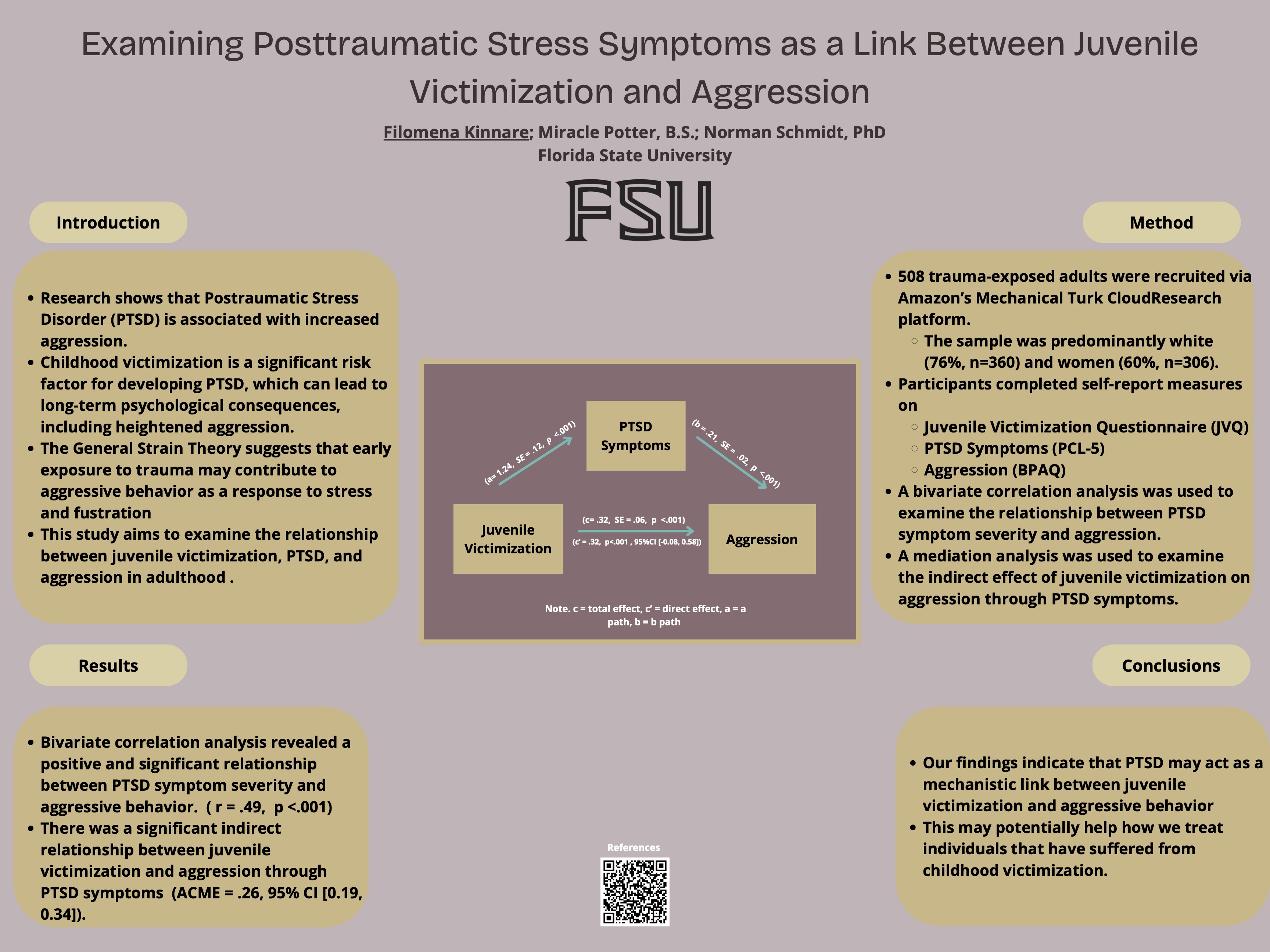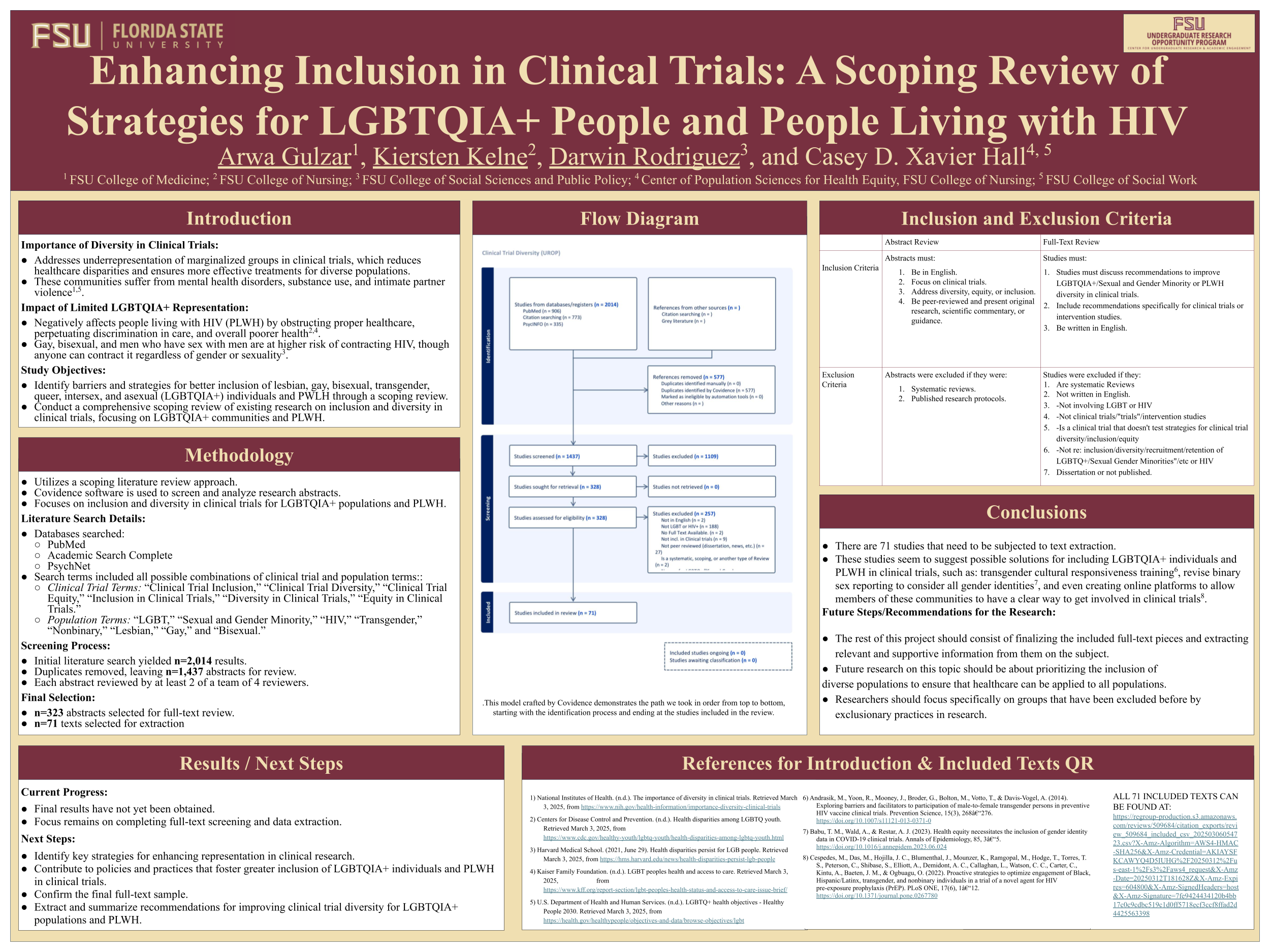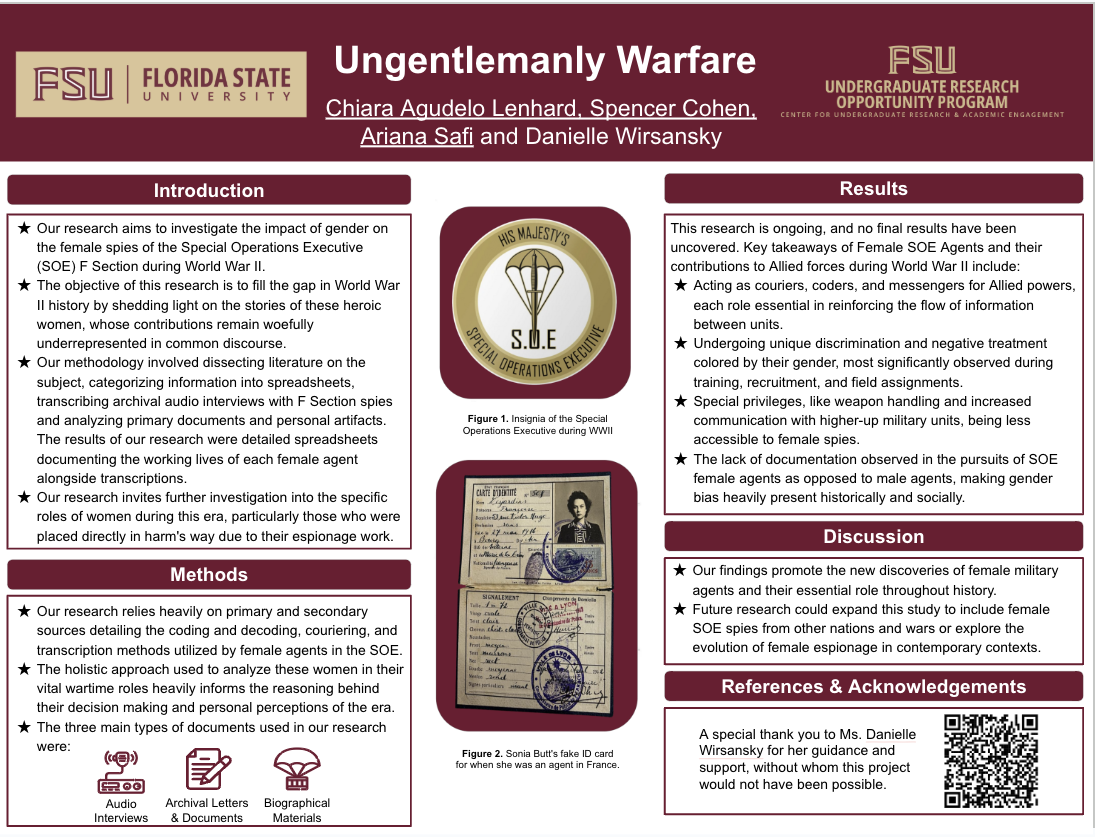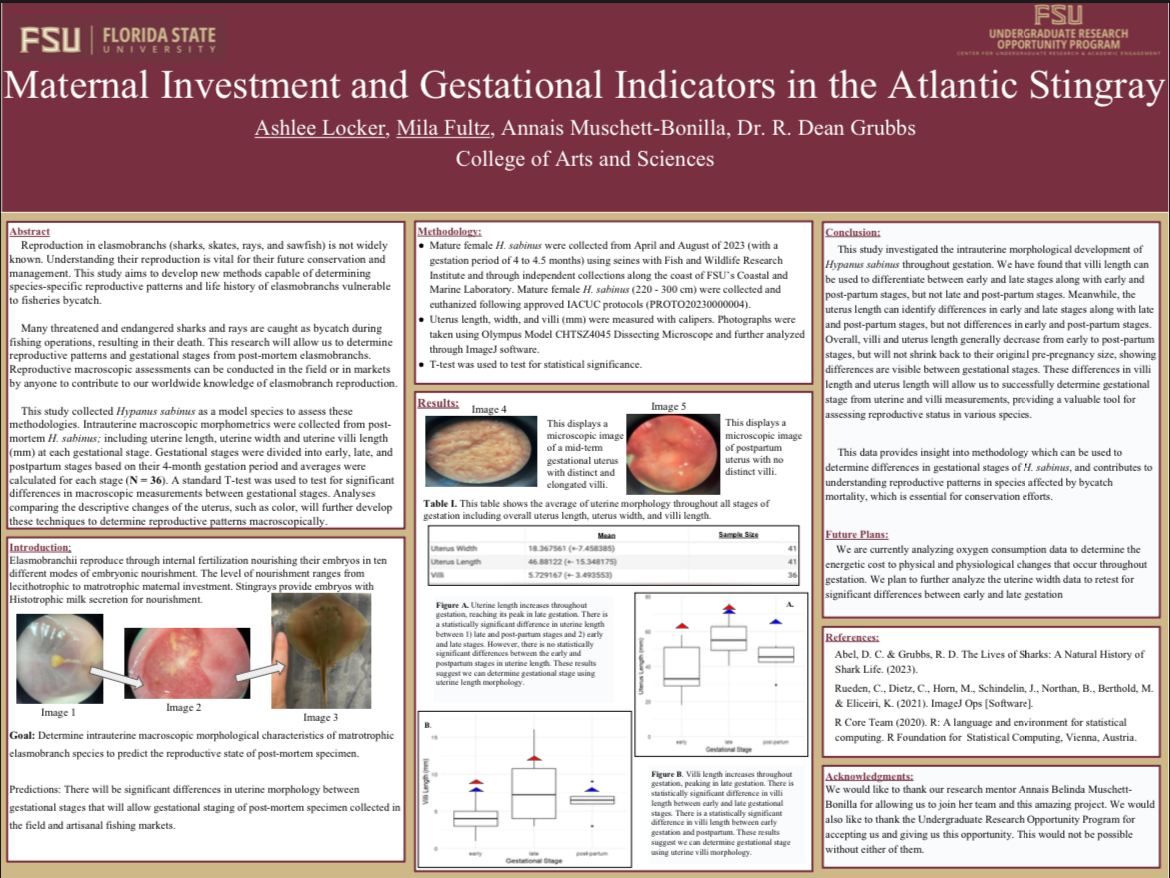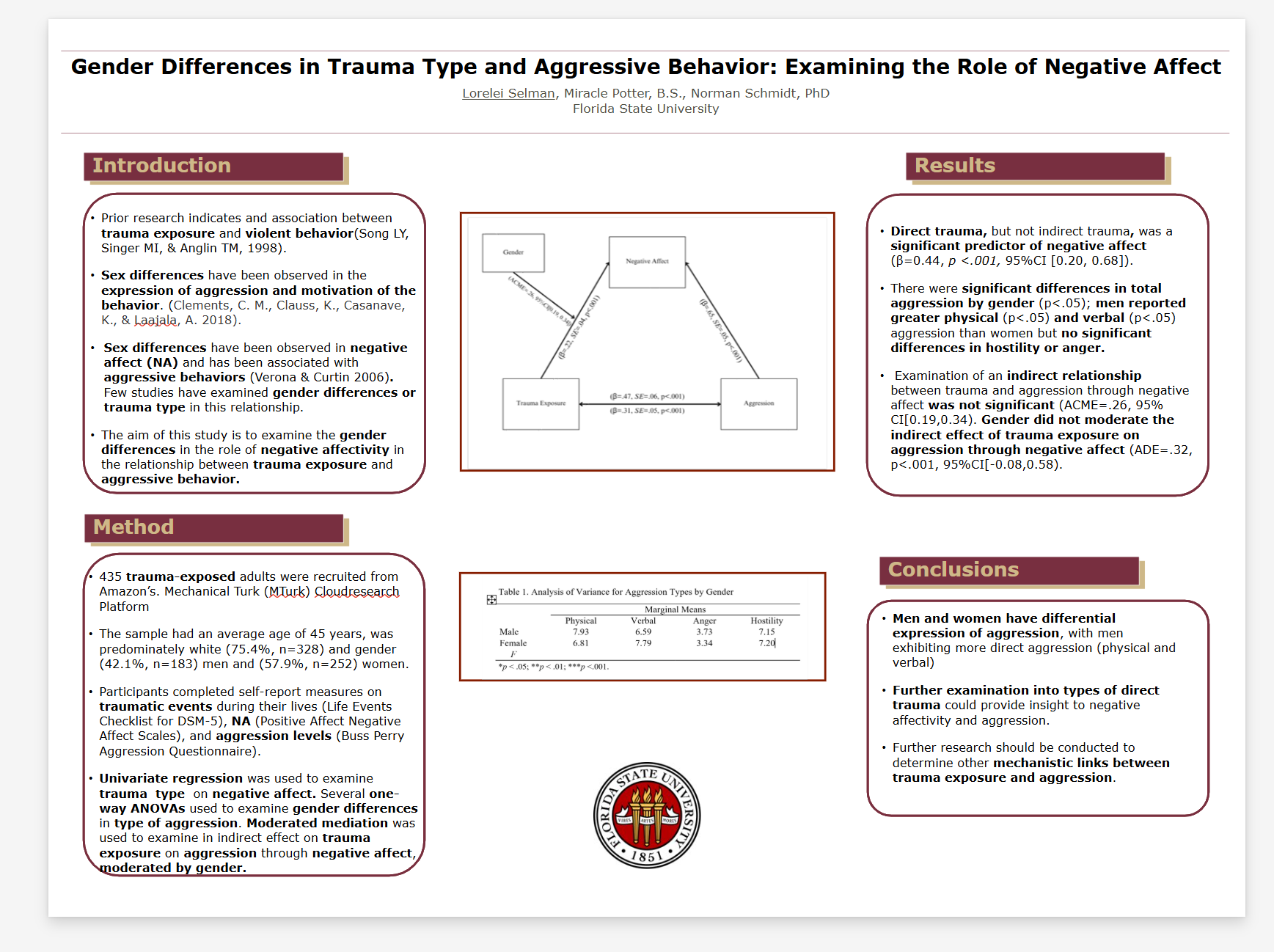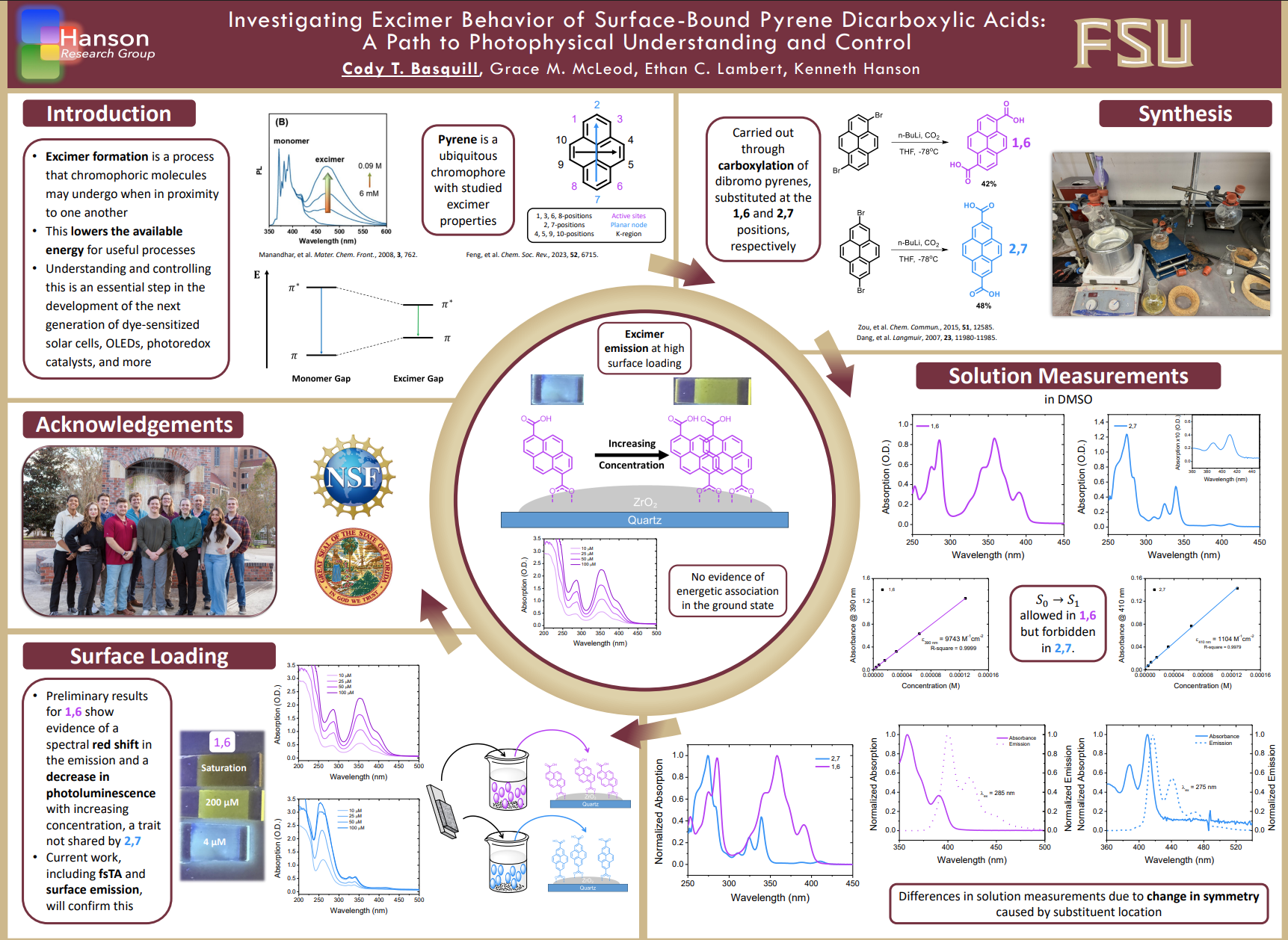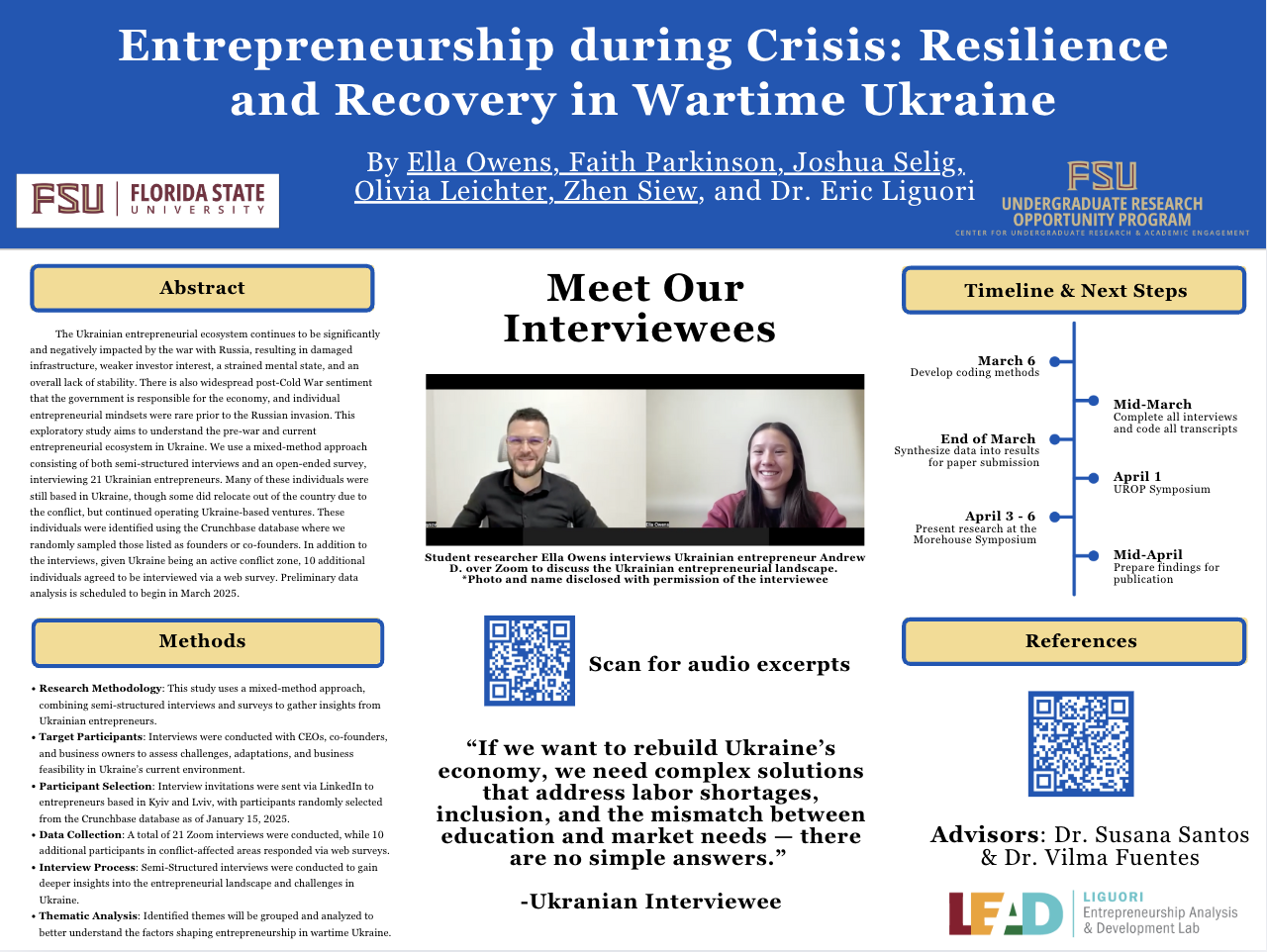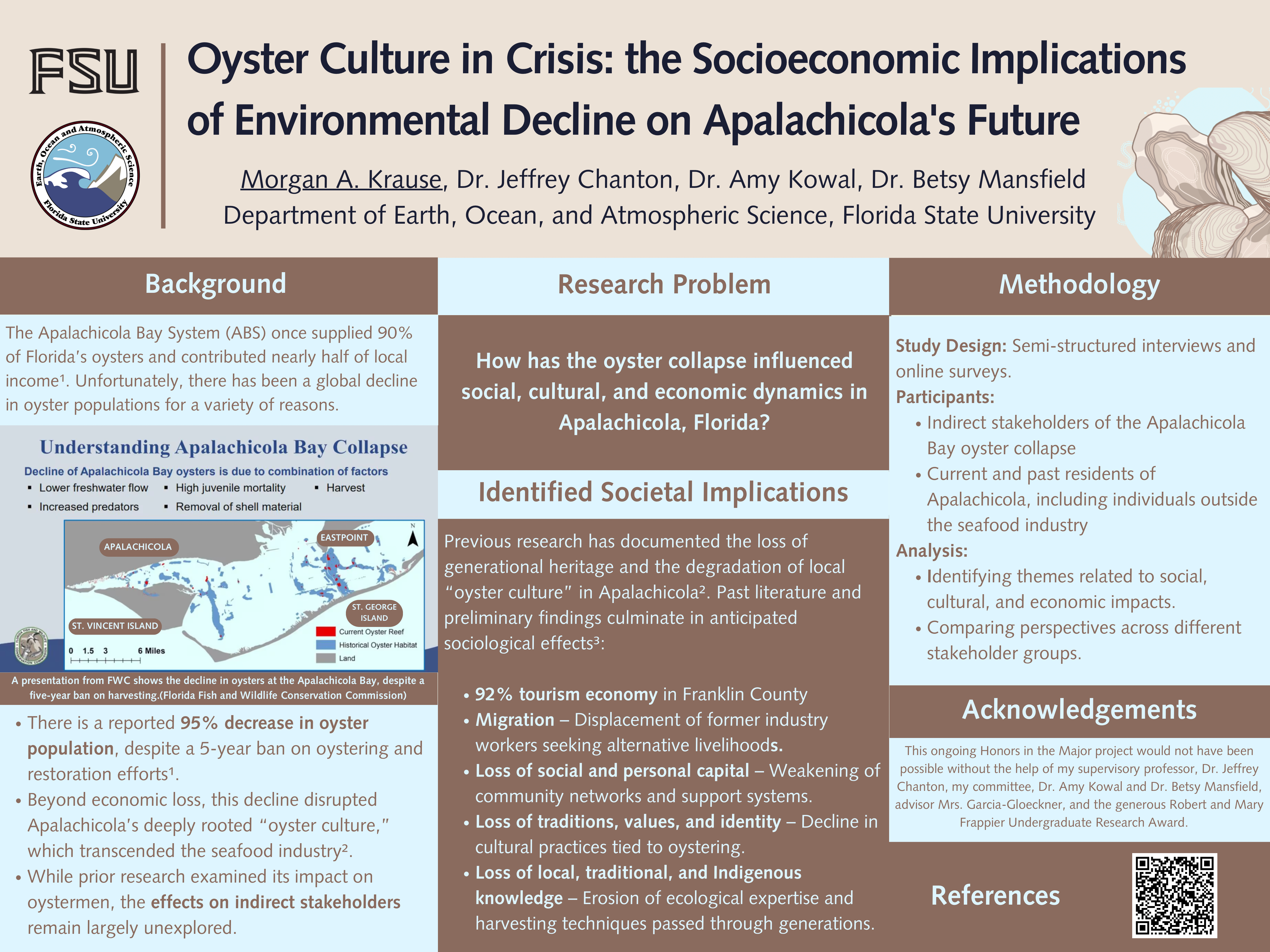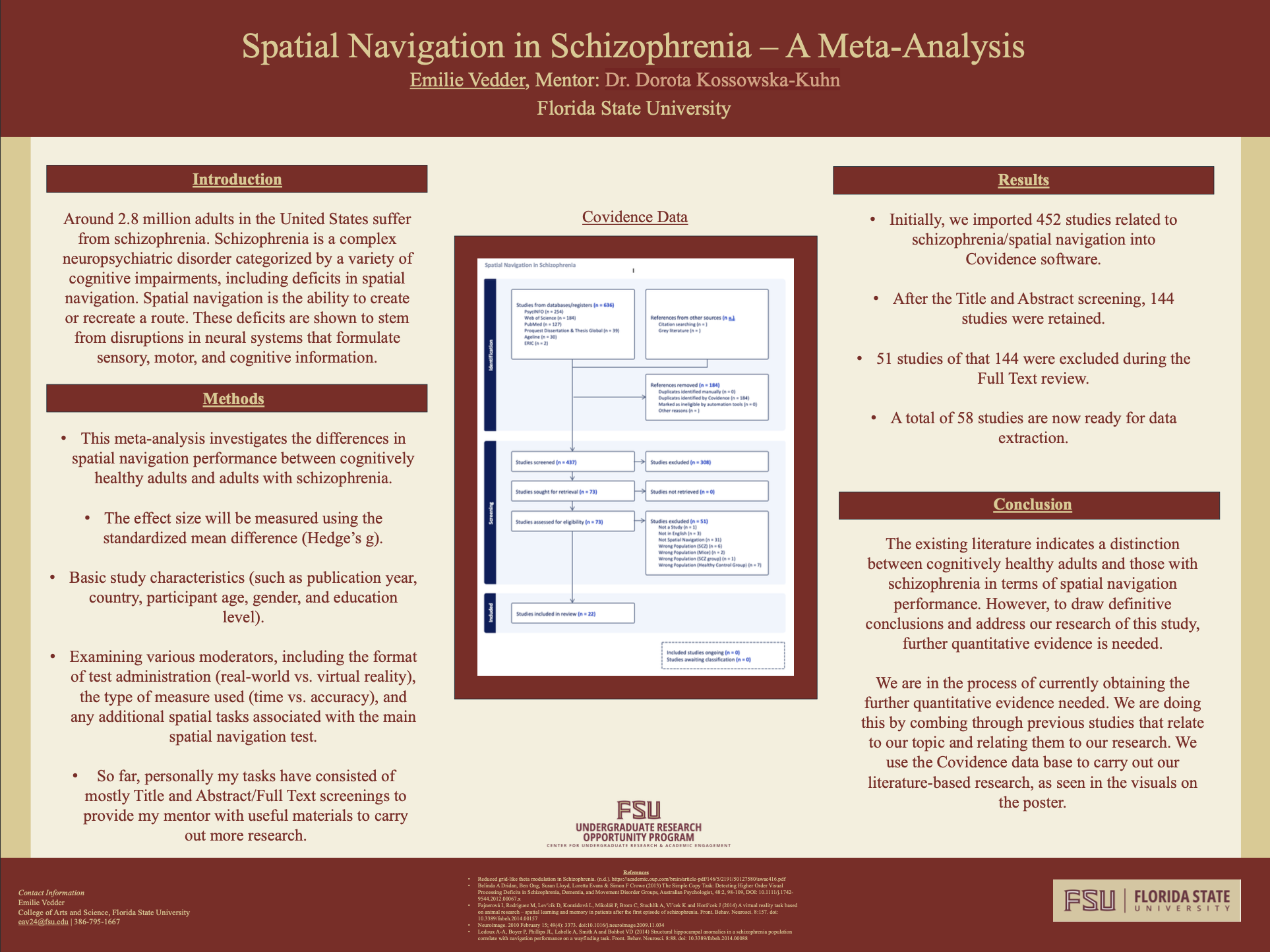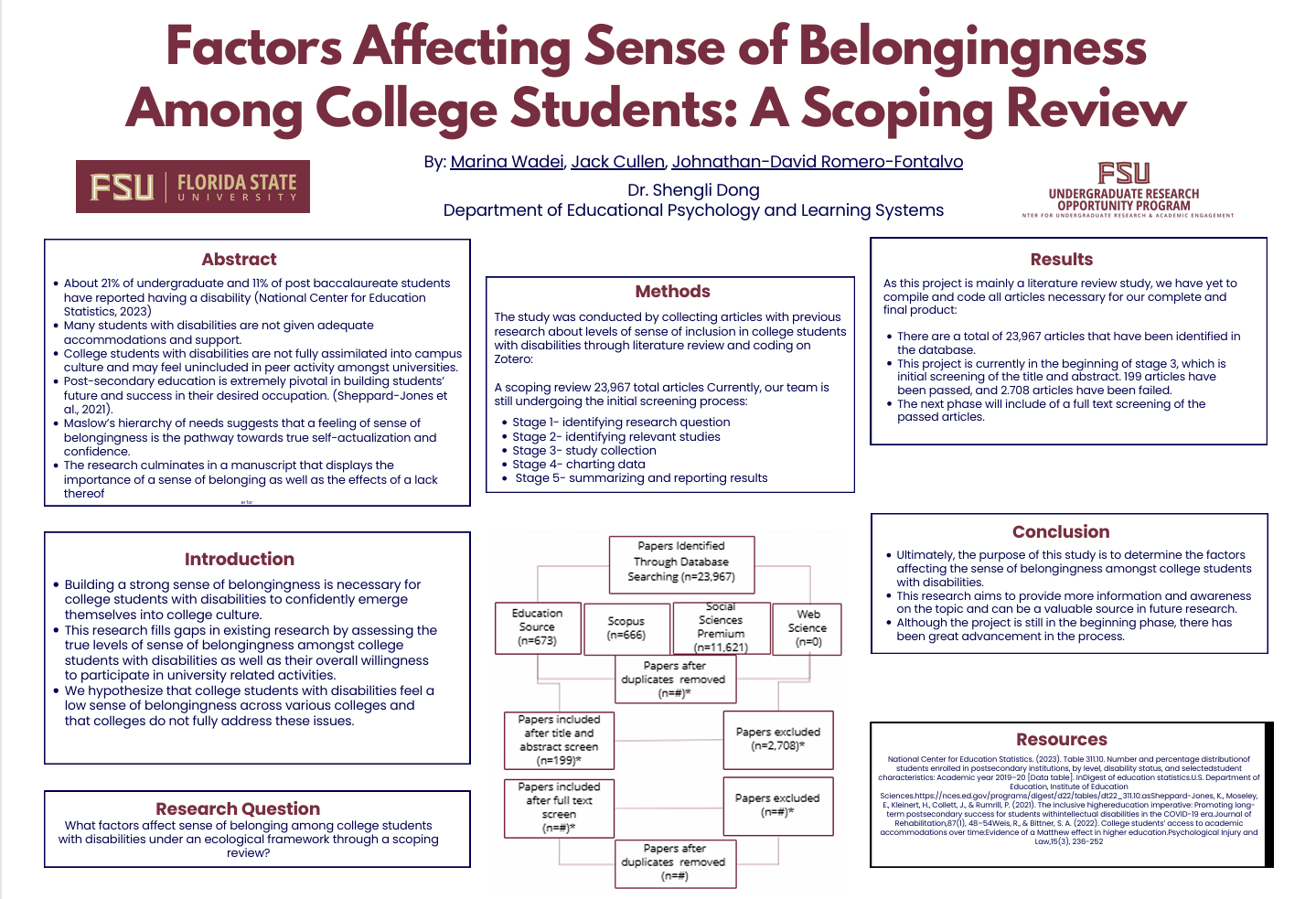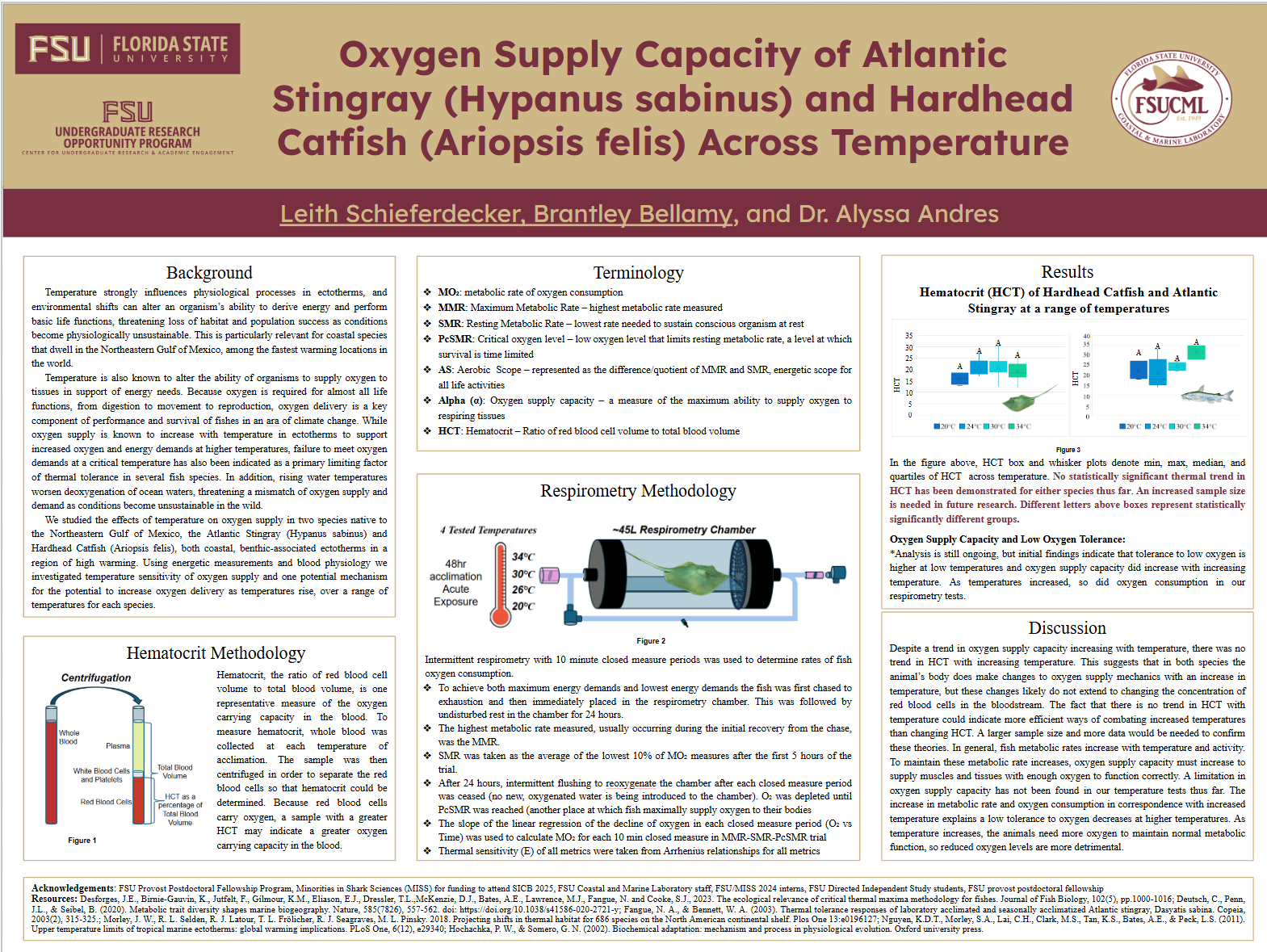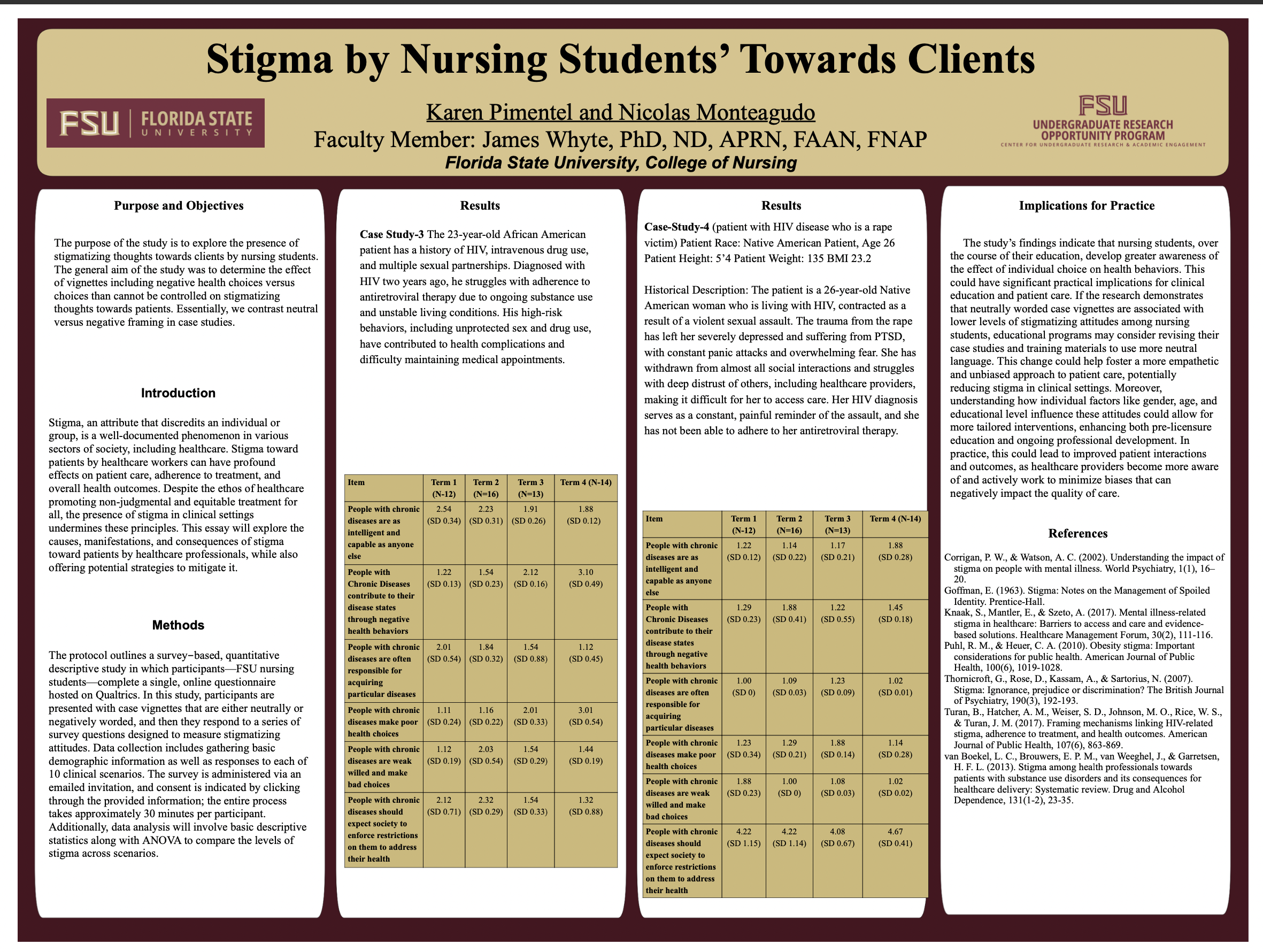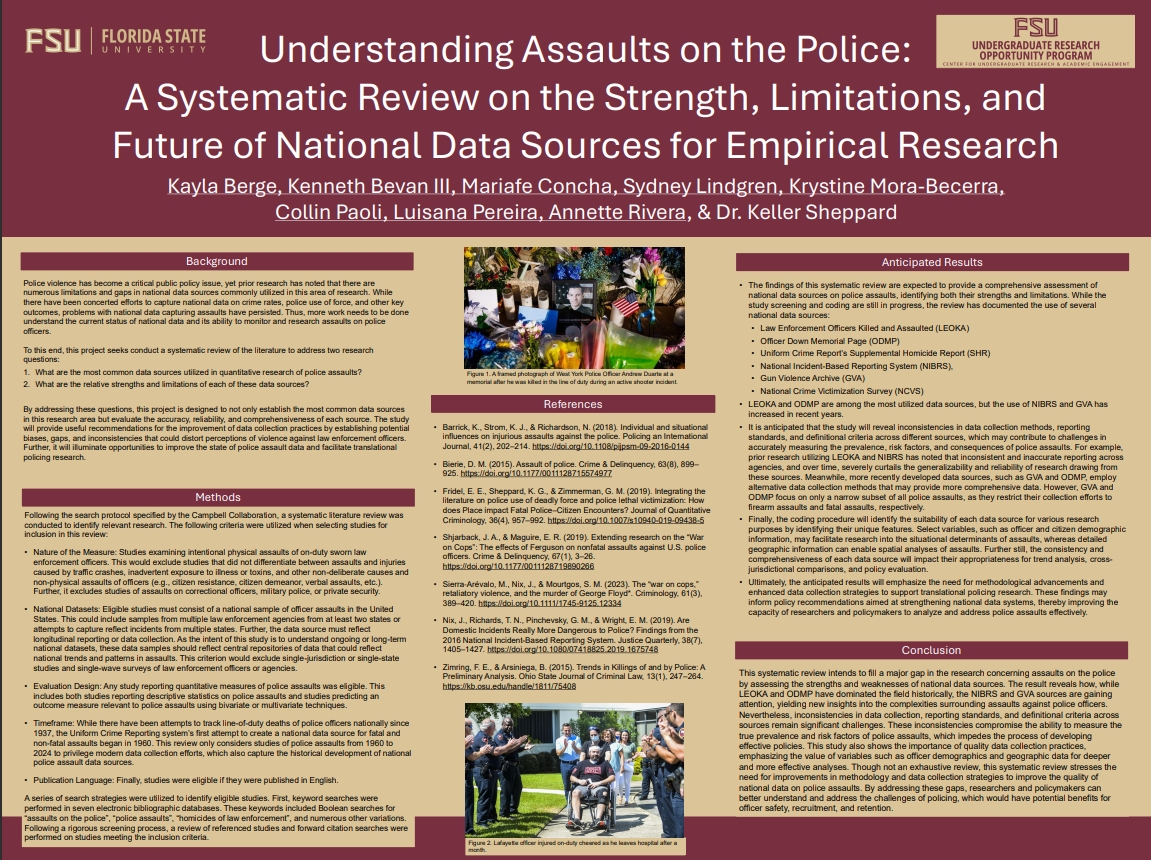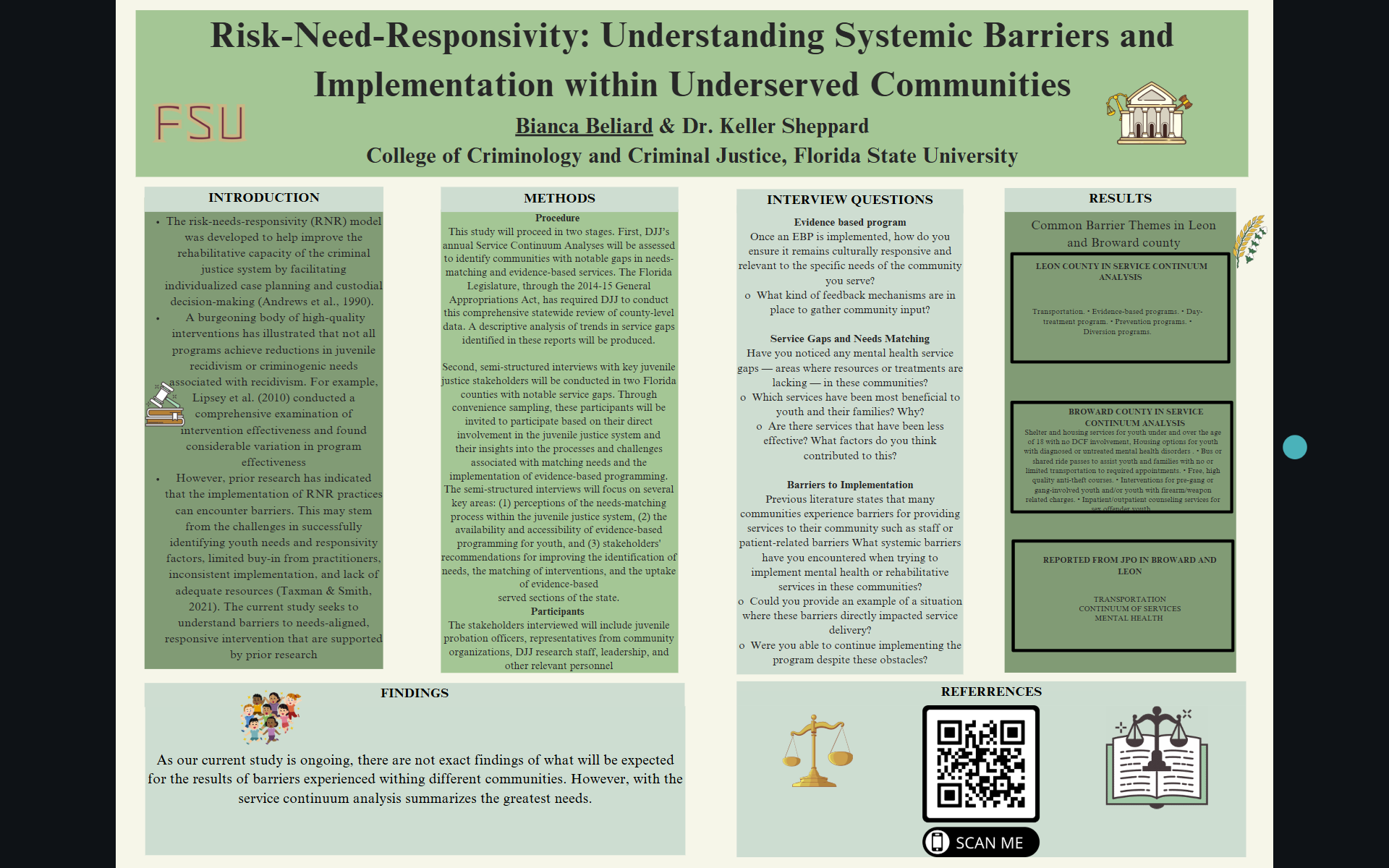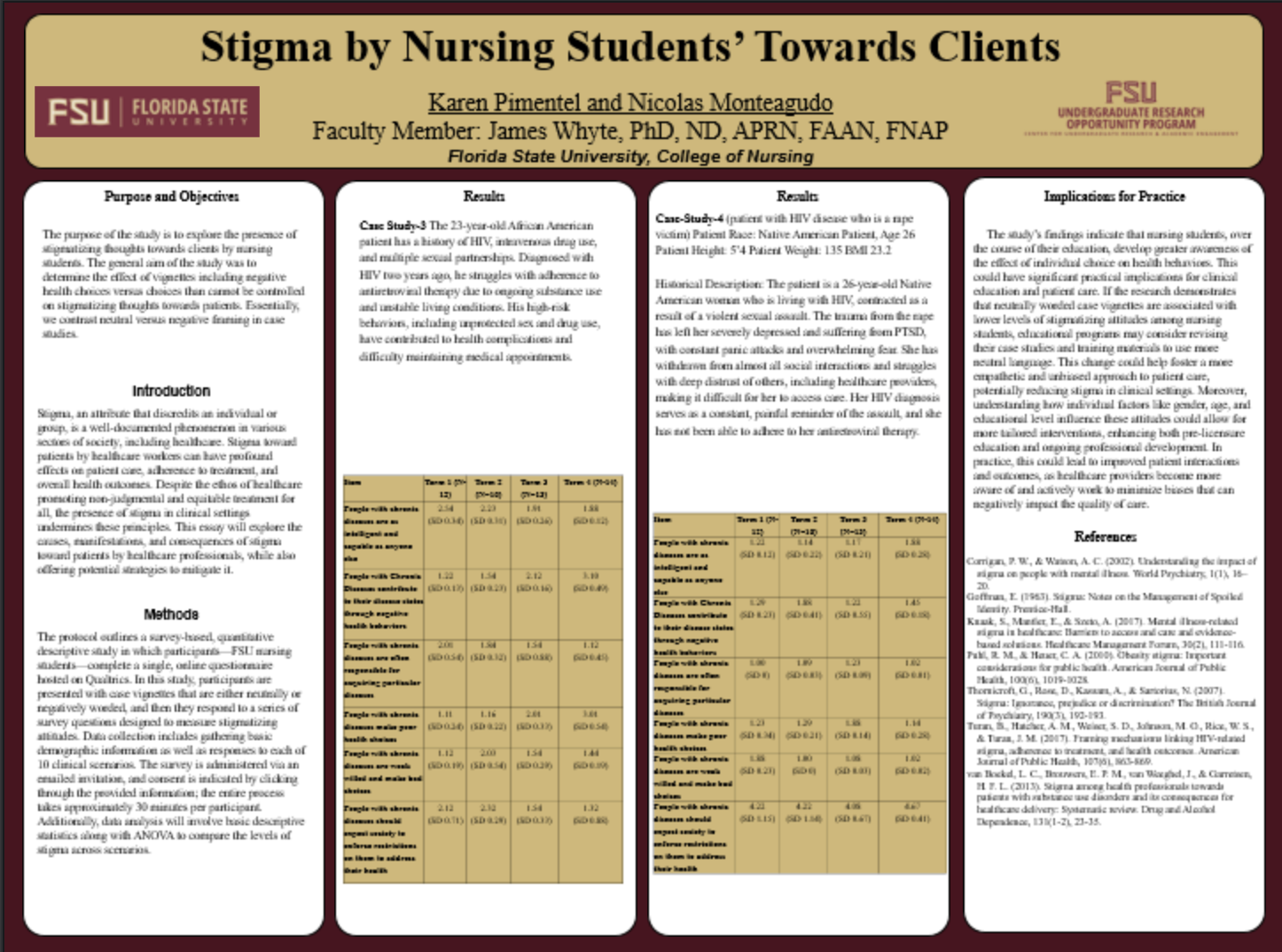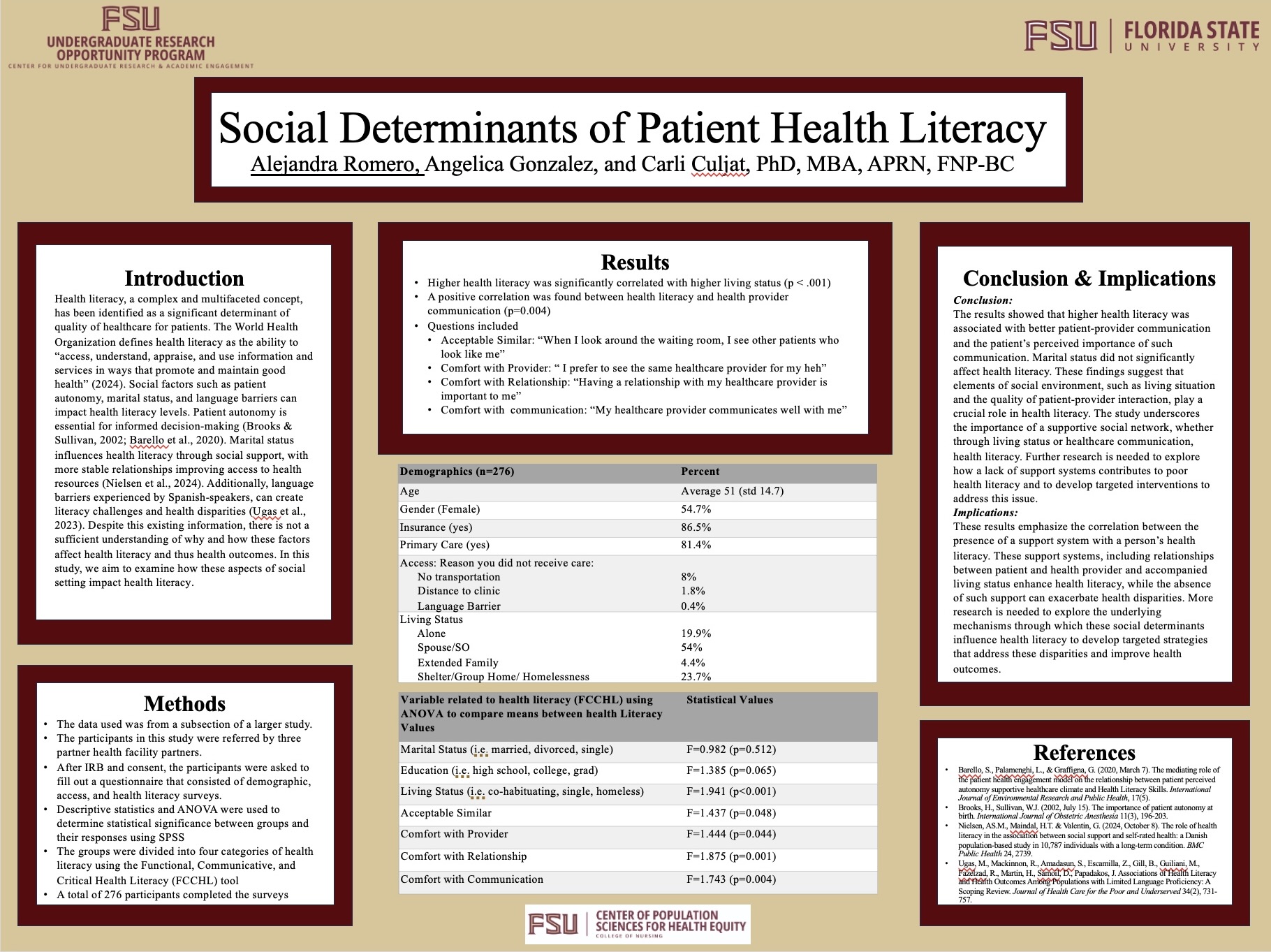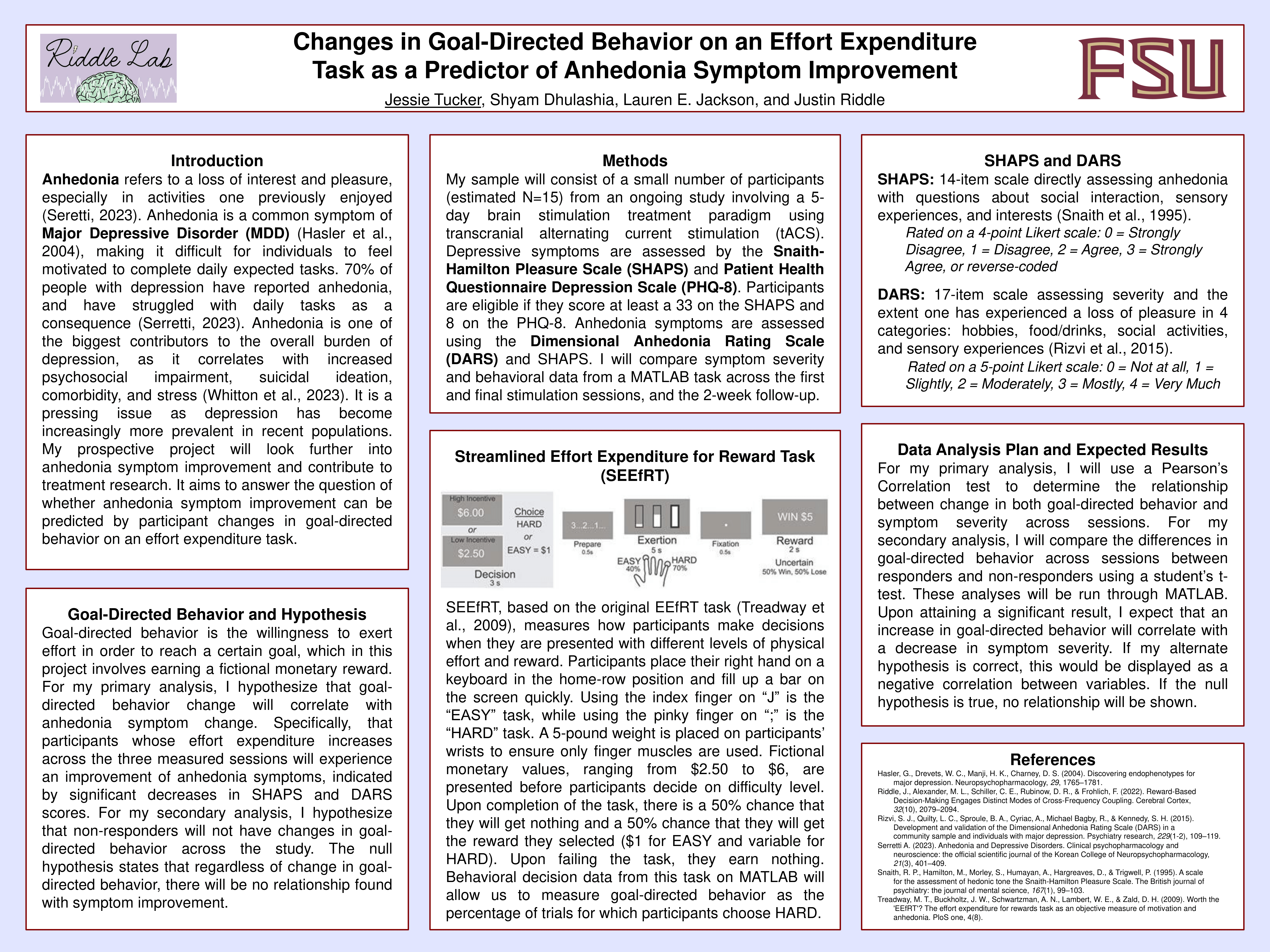Research Symposium
25th annual Undergraduate Research Symposium, April 1, 2025
Christopher Cliadakis Poster Session 2: 10:45 am - 11:45 am/ Poster #74
BIO
Hello, my name is Christopher Cliadakis. I am second-year studying Applied Mathematics and Finance. I am currently researching Physics-Informed Neural Networks (PINNs) and their use as a numerical method for solving real-world problems. After completing my undergraduate studies, I plan to pursue a master's degree in applied mathematics, with an interest in numerical analysis and dynamical systems.
Physics-Informed Neural Networks: A Deep Learning Framework for Solving Differential Equations
Authors: Christopher Cliadakis, Raghav GnanasambandamStudent Major: Applied and Computational Mathematics, Finance
Mentor: Raghav Gnanasambandam
Mentor's Department: Industrial Engineering Mentor's College: FAMU-FSU College of Engineering Co-Presenters:
Abstract
Solving Partial Differential Equations (PDEs) is a fundamental challenge in scientific computing, with applications spanning physics, engineering, and finance. Traditional numerical methods, such as finite difference and finite element methods, can be computationally expensive and struggle with high-dimensional problems. This research confirms the effectiveness of Physics-Informed Neural Networks (PINNs) as an alternative approach to generating numerical solutions for PDEs. By integrating physics-based constraints into neural network training, PINNs offer a data-efficient way to approximate solutions while maintaining accuracy.
To evaluate the performance of PINNs, a neural network model was developed and trained to solve the 1-dimensional viscous burgers equation . The accuracy of the PINN was assessed by comparing its numerical solutions to those obtained from traditional methods. The primary evaluation metrics included the number of training epochs required for convergence and the Mean Squared Error (MSE) loss, with a target threshold of 1e-4. Data collection focused on tracking model convergence and computational efficiency.
The results confirm that PINNs can approximate solutions to PDEs with competitive accuracy while potentially reducing computational complexity. These findings demonstrate the feasibility of PINNs as an alternative to conventional numerical methods, particularly in scenarios where data is limited or high-dimensional solutions are required.
This study provides valuable insights into applying deep learning techniques to numerical analysis and contributes to ongoing advancements in scientific computing.
Keywords: Machine Learning, Numerical Methods, Scientific Computing
25th annual Undergraduate Research Symposium, April 1, 2025
Eliana Arroyo Poster Session 1: 9:30 am - 10:30 am / Poster #109

BIO
Hello! My name is Eliana Arroyo, and I am a first-year Behavioral Neuroscience major at Florida State University. I am a first-generation American and was raised in Miami, Florida. During my time here at FSU, a top priority is exploring various research interests and gaining holistic knowledge in several fields. I am passionate about understanding how technology interacts with humanity, specifically the role of social media in behavioral addiction. In the future, I aspire to study public health, attend medical school, and eventually become a psychiatrist. I hope to utilize the diverse perspectives I gained researching to make advancements in the healthcare field, namely those regarding addiction and the intervention of psychiatric disorders.
Exploring Bidirectional Influences Between Social AI Interaction and Human Relationships
Authors: Eliana Arroyo, Michael IriasStudent Major: Behavioral Neuroscience
Mentor: Michael Irias
Mentor's Department: Psychology Mentor's College: College of Arts and Sciences Co-Presenters:
Abstract
Enhancements in large language models (LLMs), such as ChatGPT, have transformed human-AI interaction into a source of emotional support and bonding. As social AI finds greater acceptance, its impact on human relationships is yet to be fully explored. This study examines the bidirectional influence between AI usage and psychological well-being, specifically loneliness, depression, and attachment anxiety.
A longitudinal study was conducted with undergraduate participants (N = 26, expected N = 200) who completed baseline surveys measuring loneliness (UCLA Loneliness Scale), attachment style (Adult Attachment Questionnaire), and depression (CES-D Scale). Participants then reported daily interactions with AI and humans for three weeks, followed by a check-in survey using the same psychological measures.
Results indicated that increased time spent with AI, while controlling for human interaction, significantly reduced loneliness (B = -0.02, SE = 0.004, p < .001) and attachment anxiety (B = -0.07, SE = 0.03, p = .022). AI interaction was not significantly linked to depression change (B = -0.32, SE = 0.22, p =.156). These results imply that AI interaction could be associated with a reduction in loneliness and attachment anxiety - perhaps because it is more accessible, responsive, and non-judgmental than some human interactions. Future research could investigate the effect of AI on different demographics and the impacts of other forms of AI interfaces, like voice-operated systems. Knowledge of these associations can help guide the development of AI for social and emotional health in an era of coexistence with socially sophisticated artificial entities.
Keywords: Artificial Intelligence, Relationships, Social Psychology, Satisfaction, Human
25th annual Undergraduate Research Symposium, April 1, 2025
Filomena Kinnare Poster Session 2: 10:45 am - 11:45 am/ Poster #114
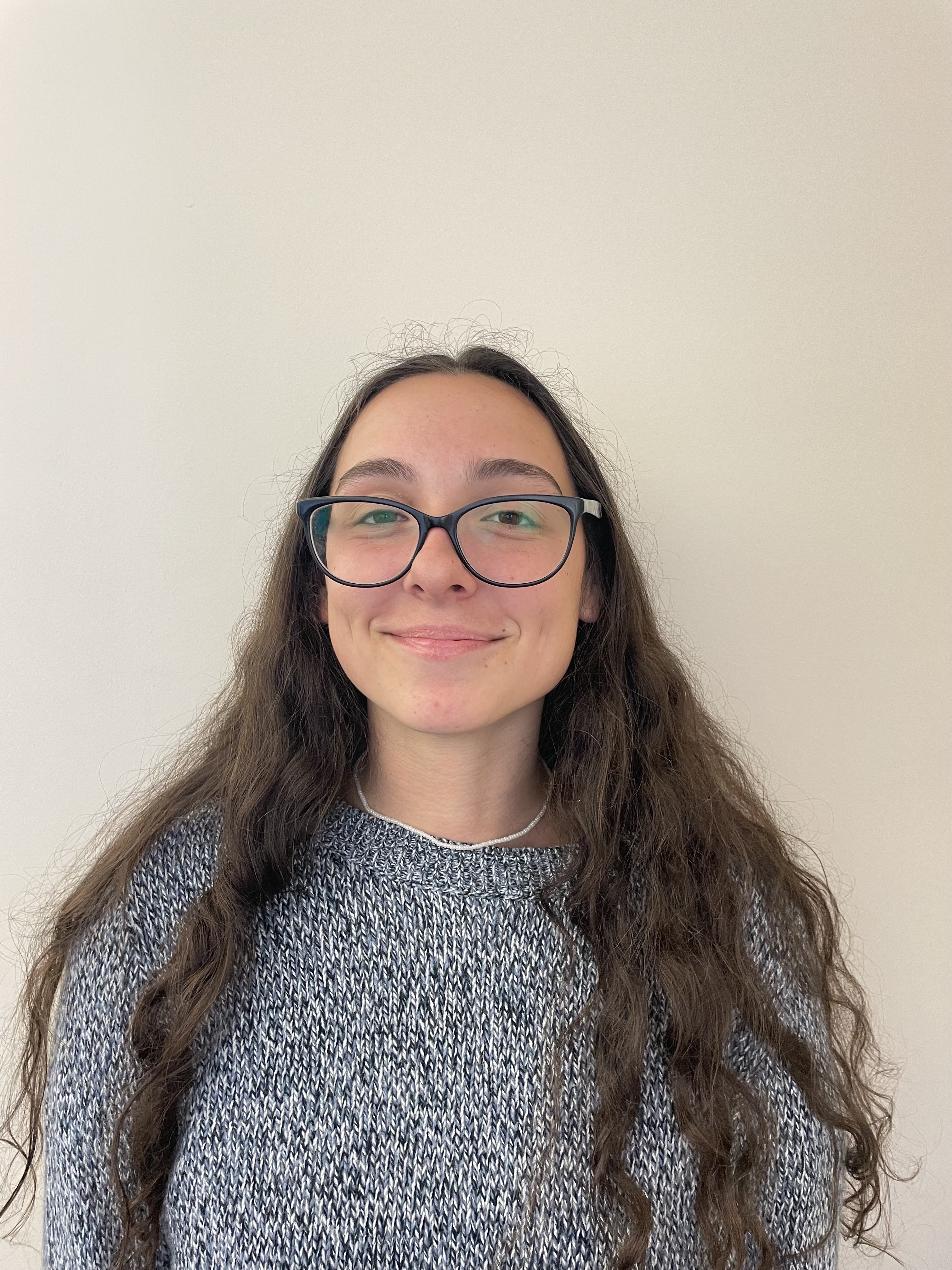
BIO
My name is Filomena Kinnare and I am from St. Augustine, Florida. I am a Senior at Florida State University. I am currently on the pre-med track and am excited to share my second research project.
Examining Posttraumatic Stress Symptoms as a Link Between Juvenile Victimization and Aggression
Authors: Filomena Kinnare, Miracle PotterStudent Major: Behavioral Neuroscience
Mentor: Miracle Potter
Mentor's Department: Clinical Psychology Mentor's College: College of Psychology Co-Presenters:
Abstract
Individuals who have experienced childhood victimization are at increased risk for negative consequences to their health and overall wellbeing in adulthood. Such consequences include trauma-related disorders like posttraumatic stress disorder (PTSD). PTSD is a debilitating disorder that complicates interpersonal effectiveness. As such, prior research has indicated a relationship between PTSD and aggression. Despite the substantial literature examining PTSD and aggression, few studies have examined this relationship in adults who endorse victimization in childhood. As such this study aims to explore this relationship to further understand the relationship between juvenile victimization, PTSD, and aggressive behavior. 504 participants who endorsed direct trauma exposure were recruited from Amazon's Mechanical Turk Cloud Research platform. Participants completed self-report questionnaires assessing PTSD symptoms, aggression, and prior juvenile victimization. Results revealed a positive and significant correlation between PTSD symptoms and aggression (r =.49, p<.001). Furthermore, a significant indirect relationship between juvenile victimization and aggression through PTSD symptoms was also found (ACME = .26, 95% CI [0.19, 0.34]). Our findings indicate that PTSD may act as a mechanistic link between juvenile victimization and aggressive behavior, potentially providing directly into how we help and treat individuals that have suffered from childhood victimization.
Keywords: Child Victimization, Aggresstion, PTSD,
25th annual Undergraduate Research Symposium, April 1, 2025
Darwin Rodriguez Jr. Poster Session 2: 10:45 am - 11:45 am/ Poster #146
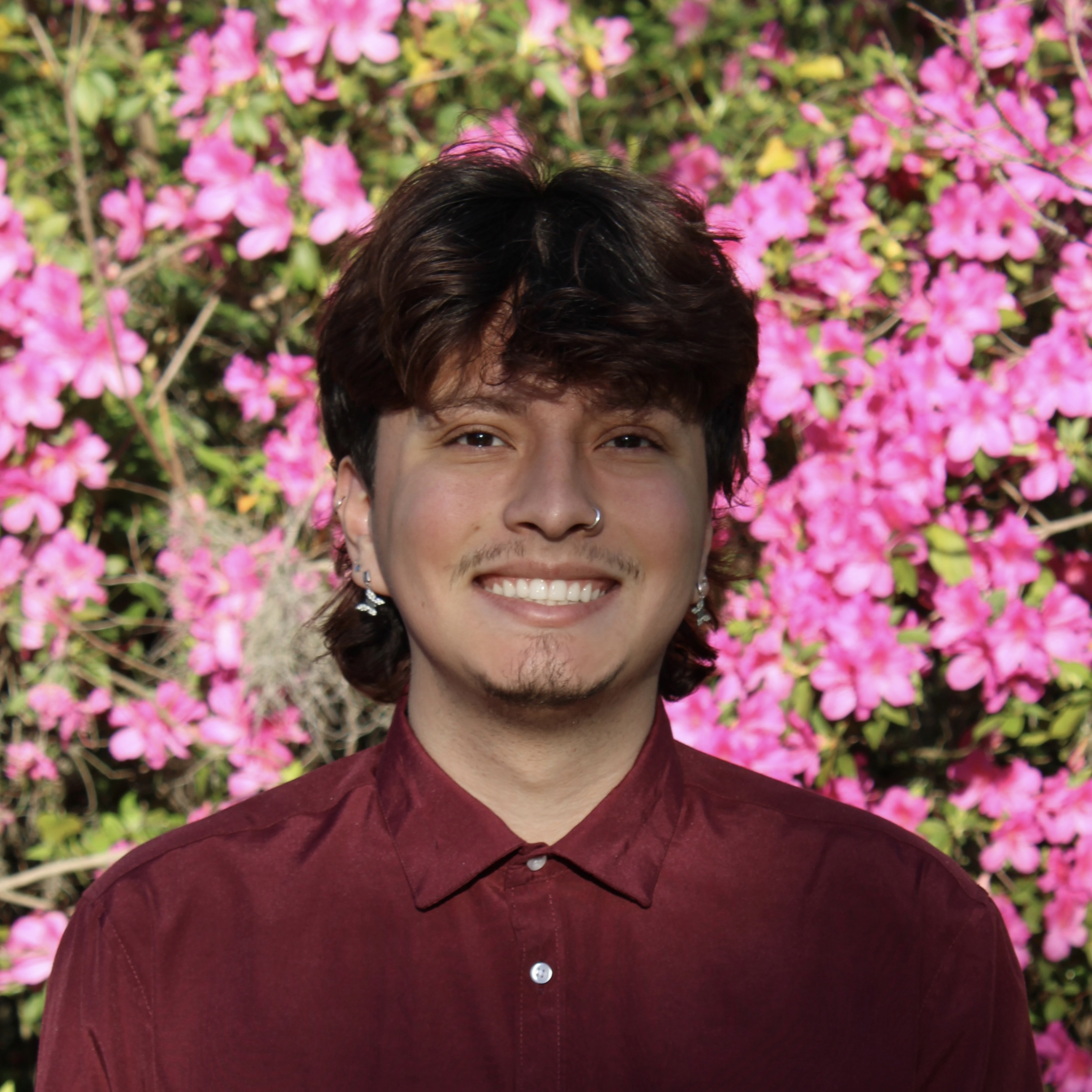
BIO
Hi! I’m Darwin Rodriguez, a third-year undergraduate student at Florida State University majoring in Interdisciplinary Social Sciences. Originally from El Salvador and Fort Lauderdale, FL, I am passionate about equity, intersectionality, and representation in research and policy. My academic interests focus on expanding access and inclusion for historically marginalized communities, particularly through public policy, community development, and research practices. As part of a collaborative research project, I've contributed to a scoping review that identifies the existing barriers and examines strategies for improving inclusion and diversity in clinical trials, particularly for LGBTQ+ individuals. I hope this work will inform more equitable research practices and better health outcomes for underrepresented groups. After graduation, I plan to pursue graduate studies in urban and regional planning or public administration, with a focus on addressing systemic inequalities in areas like housing, healthcare, and infrastructure through inclusive, community-centered approaches.
Enhancing Inclusion in Clinical Trials: A Scoping Review of Strategies for LGBTQIA+ People and People Living with HIV
Authors: Darwin Rodriguez Jr., Dr. Casey Xavier HallStudent Major: Interdisciplinary Social Sciences
Mentor: Dr. Casey Xavier Hall
Mentor's Department: Center of Population Sciences for Health Equity Mentor's College: College of Nursing, College of Social Work Co-Presenters: Arwa Gulzar, Kiersten Kelne
Abstract
Including diverse populations in research is crucial for addressing the underrepresentation of marginalized groups in clinical trials, which can lead to healthcare disparities and less effective treatments for diverse populations. By identifying barriers and strategies for better inclusion of lesbian, gay, bisexual, transgender, queer, intersex, and asexual (LGBTQIA+) individuals and people living with HIV (PLWH), the study aims to inform policy and guidance for practice that fosters more equitable representation and improve health outcomes for these communities. A lack of LGBTQIA+ diversity in clinical trials also negatively impacts individuals living with HIV as gay, bisexual, and men who have sexual intercourse with other men are more likely to contract HIV; however, people of any gender or sexuality may contract HIV. People living with HIV experience increased comorbidities such as pain, sleep disruption, cardiovascular disease, and cognitive decline, among others. Yet, PLWH is often excluded from clinical trials addressing treatments for these conditions. The underlying goal of this project is to perform a comprehensive scoping review of existing research on inclusion and diversity in clinical trials, particularly for the LGBTQIA+ community and PLWH From this, the goal is to help summarize potential strategies for improving representation and highlight gaps in the literature. Improving clinical trial diversity will ultimately improve access to treatments and technologies that improve the health of LGBTQIA+ people and PLWH.
Keywords: LGBT, LGBTQ+, LGBTQ, HIV, AIDS, Diversity, Equity, Inclusion
25th annual Undergraduate Research Symposium, April 1, 2025
Ariana Safi Poster Session 3: 1:45 pm - 2:45 pm / Poster #46

BIO
Hello, my name is Ariana Safi. I grew up in Honolulu, Hawaii and currently attend FSU as a Freshman. I am a psychology and biology double major on the pre-med track. I have travelled to Europe over fifteen times and have a deep interest in French, German, and British History.
Ungentlemanly Warfare
Authors: Ariana Safi, Danielle WirsanskyStudent Major: Psychology
Mentor: Danielle Wirsansky
Mentor's Department: History Mentor's College: Florida State University Co-Presenters: Chiara Agudelo Lenhard, Spencer Cohen
Abstract
Our research aims to investigate the impact of gender on the female spies of the Special Operations Executive (SOE) F Section during World War II. Historically, the documentation of these female spies has been overlooked, biased, and not an accurate representation of their immense work and sacrifices. This research aims to fill the gap in World War II history by shedding light on the stories of these heroic women, exposing the trials and tribulations of the agents in the SOE F Section, whose contributions remain woefully underrepresented in common discourse. Our methodology involved dissecting literature on the subject, categorizing information into spreadsheets, transcribing archival audio interviews with F Section spies, analyzing primary documents and personal artifacts. The results of our research were detailed spreadsheets documenting the working lives of each female F Section agent. Our research invites further investigation into the specific roles of women during this era, particularly those who were placed directly in harm's way due to their espionage work. Future research could expand this study to include female SOE spies from other nations and wars or explore the evolution of female espionage in contemporary contexts. Ultimately, this study emphasizes the crucial yet often neglected contributions of female operatives to the success of Allied forces and aims to restore their rightful place in history.
Keywords: WWII, Feminist, History
25th annual Undergraduate Research Symposium, April 1, 2025
Mila Fultz Poster Session 4: 3:00 pm - 4:00 pm/ Poster #184

BIO
Hi, my name is Mila Fultz and I’m a sophomore biology major interested in Obstetrics and Gynecology, along with understanding female reproductive health. My research covers the reproductive morphometrics of Atlantic Stingrays, and techniques that can be used to track their gestational progress.
Maternal Investment and Gestational Indicators in the Atlantic Stingray
Authors: Mila Fultz, Annais Muschett-BonillaStudent Major: Biological Sciences
Mentor: Annais Muschett-Bonilla
Mentor's Department: Biological Sciences Mentor's College: College of arts and sciences Co-Presenters: Ashlee Locker
Abstract
Reproduction in elasmobranchs (sharks, skates, rays, and sawfish) is not widely known. Understanding their reproduction is vital for their future conservation and management. This study aims to develop new methods capable of determining species-specific reproductive patterns and life history of elasmobranchs vulnerable to fisheries bycatch. Many threatened and endangered sharks and rays are caught as bycatch during fishing operations, resulting in their death. This research will allow us to determine reproductive patterns and gestational stages from post-mortem elasmobranchs. Reproductive macroscopic assessments can be conducted in the field or in markets by anyone to contribute to our worldwide knowledge of elasmobranch reproduction. This study collected Hypanus sabinus as a model species to assess these methodologies. Intrauterine macroscopic morphometrics were collected from post-mortem H. sabinus; including uterine length, uterine width and uterine villi length (mm) at each gestational stage. Gestational stages were divided into early, late, and postpartum stages based on their 4-month gestation period and averages were calculated for each stage (N = 36). A standard T-test was used to test for significant differences in macroscopic measurements between gestational stages. Analyses comparing the descriptive changes of the uterus, such as color, will further develop these techniques to determine reproductive patterns macroscopically.
Keywords: Maternal Investment, Biology, Atlantic Stingrays
25th annual Undergraduate Research Symposium, April 1, 2025
Lorelei Selman Poster Session 3: 1:45 pm - 2:45 pm / Poster #251

BIO
Hi! My name is Lorelei Selman. I was born in Miami, FL but moved to Tallahassee when I was 7 years old. I am a first generation American citizen, my family coming from the Dominican Republic. I am most interested in research regarding the origins of criminal behavior, especially for children. Finding the best treatment plans for teens and young adults to keep them from reentering the legal system is something I am very passionate about, and would love to pursue. I am planning on entering the MSW program here at FSU and going into clinical social work.
Gender Differences in Trauma Type and Aggressive Behavior: Examining the Role of Negative Affect
Authors: Lorelei Selman, Miracle PotterStudent Major: Psychology, Criminology and Criminal Justice
Mentor: Miracle Potter
Mentor's Department: Psychology Mentor's College: Arts and Sciences Co-Presenters:
Abstract
Trauma exposure has been associated with aggressive behavior, yet the mechanisms linking trauma to aggression remain unclear. Prior research has implicated negative affect as a factor that may explain the connection between trauma exposure and aggression; however, there is limited research considering the role of gender in this relationship. Moreover, the type of trauma exposure has been implicated in aggression research, but few studies have examined negative affectivity and gender concurrently in this relationship. As such, this study explores the impact of trauma type on negative affect, gender differences in aggressive behavior, the role of negative affect in mediating the relationship between trauma exposure and aggression and how gender may moderate this relationship. 435 trauma-exposed adults were recruited using Amazon Mechanical Turk Cloud Research platform and completed self-report questionnaires assessing trauma history, negative affectivity, and aggression levels. Results indicated that direct trauma exposure, rather than indirect exposure, significantly predicted negative affectivity (b=.32, CI [-0.08, 0.58], p=<.001). Gender differences in overall aggression were observed, with males reporting slightly higher aggression than women ( p<.001). Additionally, when examining the components of aggression, men also reported significantly more physical (p<.001) and verbal aggression (p<.001), however no differences were observed for hostility and anger(p>.001). Furthermore, negative affect did not mediate the relationship between trauma and aggression, and gender did not moderate the proposed mediated relationship. These findings suggest that other factors may be involved in the trauma-aggression link, highlighting the need for further research to explore additional moderators and mediators.
Keywords: aggression, negative affect, trauma, indirect trauma, direct trauma
25th annual Undergraduate Research Symposium, April 1, 2025
Cody Basquill Poster Session 2: 10:45 am - 11:45 am/ Poster #70
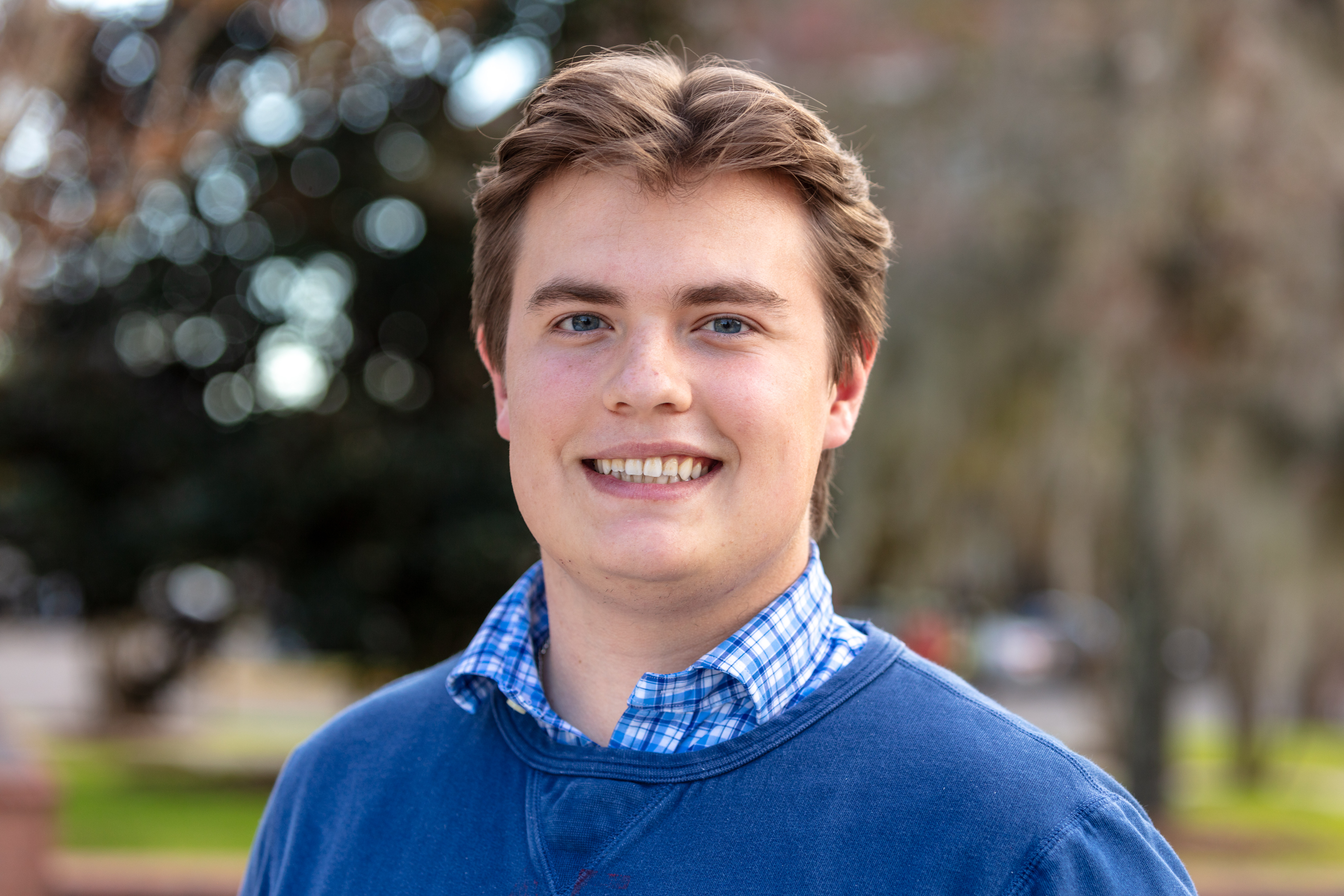
BIO
Cody hails from Tampa, FL. As a dual degree student in Chemistry and World Languages, Cody hopes to combine his academic interests to further his research endeavors in chemistry. After graduating from FSU, Cody plans to pursue a Ph.D. in Physical Chemistry to research at the forefront of solar energy development. Using his background in world languages, Cody plans to share these photophysical insights globally and bring efficient ways of harnessing the world's most abundant energy source to the places that need it most.
Investigating Excimer Behavior of Surface-Bound Pyrene Dicarboxylic Acids: A Path to Photophysical Understanding and Control
Authors: Cody Basquill, Dr. Kenneth HansonStudent Major: Chemistry; French & Spanish Co-major
Mentor: Dr. Kenneth Hanson
Mentor's Department: Chemistry & Biochemistry Mentor's College: Arts and Sciences Co-Presenters:
Abstract
The interactions between molecular chromophores/fluorophores can have a profound impact on their utility in a variety of applications including solar energy conversion, light emitting diodes, and biochemical sensing. When exposed to light, these molecules may form excimers, which lower the excited state energy and provide an alternate pathway to relaxation that competes with desirable events like the generation of light or electrical current. Here, we investigate the structural parameters that dictate light-driven intermolecular interactions via two pyrene dicarboxylic acid derivatives. Pyrene molecules substituted with carboxylic acid surface binding groups at the 1,6 and 2,7 positions, respectively, are used to probe how the orientation and surface coverage of the molecule impact its photophysical properties at the interface. Steady-state and time-resolved spectroscopy are used to show that each molecule possesses unique photophysical properties that may elucidate larger patterns that are common to many varieties of organic chromophores, allowing for better understanding and control of undesirable processes.
Keywords: Chemistry, Light, Physics, Molecules, Energy
25th annual Undergraduate Research Symposium, April 1, 2025
Olivia Leichter Poster Session 3: 1:45 pm - 2:45 pm / Poster #84
BIO
Hailing from North Dakota and now based in Sarasota, FL, Olivia Leichter is passionate about music, craftsmanship, and business. Going forward, she plans to pursue an Honors in the Major project that focuses on the art of violin-making, and conducting research through hands-on apprenticeship studies overseas. This unique exploration blends historical craftsmanship with modern innovation, reflecting a deep appreciation for both tradition and artistry.In addition to her passion for music, Olivia is interested in the risk management and insurance industry, with aspirations to own her own business. Combining creativity with strategic thinking, she aims to build a career that bridges artistry and entrepreneurship.
Beyond academics, Olivia is actively involved in leadership and service. She holds leadership roles within the Inter-Residence Hall Council (IRHC) and the Panhellenic sorority, Pi Beta Phi, and is a member of the National Residence Hall Honorary (NRHH) and the FSU College of Music Board of Advisors. Moreover, she is learning Korean and Ukrainian and pursuing a Global Citizenship Certificate through FSU.
With a commitment to leadership, scholarship, and innovation, Olivia is passionate about contributing positively to her community, and eager to make an impact in both the music and business worlds.
Entrepreneurship during Crisis: Resilience and Recovery in Wartime Ukraine
Authors: Olivia Leichter, Dr. Eric LiguoriStudent Major: (Dual-Degree) B.A. Violin, B.S. Risk Management & Insurance
Mentor: Dr. Eric Liguori
Mentor's Department: LEAD Lab: Entrepreneurship Analysis & Development Lab Mentor's College: Jim Moran College of Entrepreneurship Co-Presenters: Ella Owens, Faith Parkinson, Joshua Selig, Zhen Siew
Abstract
The Ukrainian entrepreneurial ecosystem continues to be significantly and negatively impacted by the war with Russia, resulting in damaged infrastructure, weaker investor interest, a strained mental state, and an overall lack of stability. There is also widespread post-Cold War sentiment that the government is responsible for the economy, and individual entrepreneurial mindsets were rare prior to the Russian invasion. This exploratory study aims to understand the pre-war and current entrepreneurial ecosystem in Ukraine. We use a mixed-method approach consisting of both semi-structured interviews and an open-ended survey, interviewing 21 Ukrainian entrepreneurs. Many of these individuals were still based in Ukraine, though some did relocate out of the country due to the conflict, but continued operating Ukraine-based ventures. These individuals were identified using the Crunchbase database where we randomly sampled those listed as founders or co-founders. In addition to the interviews, given Ukraine being an active conflict zone, 10 additional individuals agreed to be interviewed via a web survey. Preliminary data analysis is scheduled to begin in March 2025.
Keywords: Ukraine, Economic Recovery, Entrepreneurship
25th annual Undergraduate Research Symposium, April 1, 2025
Morgan Krause Poster Session 1: 9:30 am - 10:30 am/ Poster #164
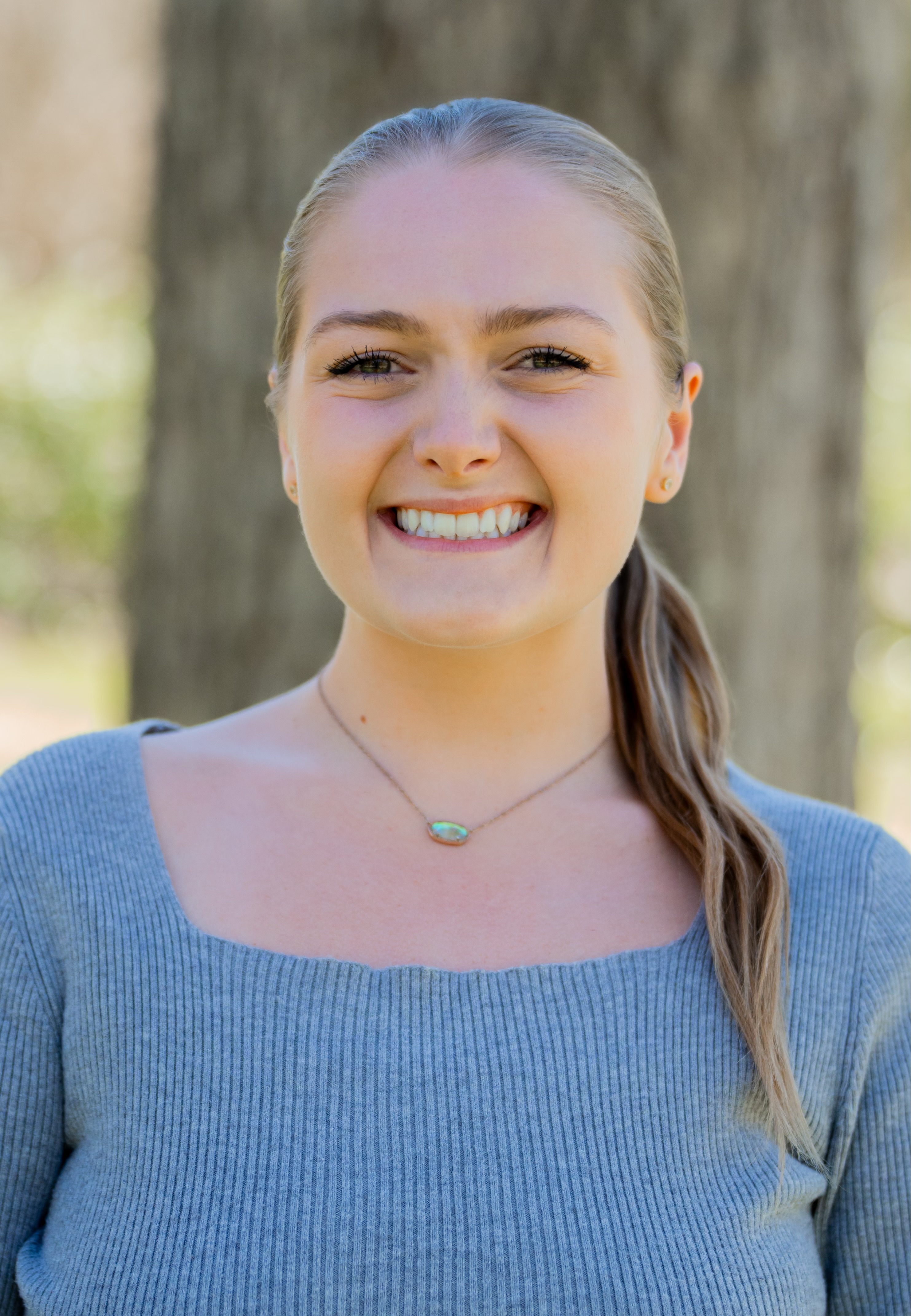
BIO
My name is Morgan Krause and I am from Tampa, Florida. I am a junior studying Environmental Science and Policy, working towards attending law school in the near future. Describing my current involvements, I am the president of the Maji Project, a student-led organization dedicated to tackling the water crisis. I have an on-campus job as a University Ambassador, representing FSU and the Admissions team during prospective and admitted student tours, Admissions panels, and more. Outside of my student involvements, I am also invested in completing my Honors in the Major thesis in the fall of 2025. I am honored to have been recently awarded the Robert and Mary Frappier Undergraduate Research Award through FSU’s IDEA grant program. With my current research, I intend to connect societal and environmental wellbeing by interviewing residents in a rural, coastal community that have faced catastrophic environmental disturbances over the course of multiple decades.
Oyster Culture in Crisis: the Socioeconomic Implications
Authors: Morgan Krause, Dr. Jeffrey ChantonStudent Major: Environmental Science and Policy
Mentor: Dr. Jeffrey Chanton
Mentor's Department: Earth, Ocean, and Atmospheric Sciences Mentor's College: Arts and Sciences Co-Presenters:
Abstract
The collapse of the oyster population in Apalachicola Bay, Florida, has had profound socioeconomic and cultural consequences beyond those observed within the seafood industry (Brown, 2016). Historically, the Bay supplied 90% of Florida’s and 10% of the nation's wild oysters, supporting thousands of jobs (FWC, 2024). In 2012, oyster population declined drastically, prompting a harvesting ban in 2020. While the oyster industry was once prominent in the areas surrounding Apalachicola Bay, the economy is now 92% tourism based based on recent FWC reporting. Apalachicola, and Franklin County, are both rural and coastal, leading to vulnerability and a prominent need for initiatives that foster stakeholder engagement. In order to include a diverse pool of stakeholders, there must be investigation into the number of individuals currently left out of the decision-making process.
Using a social-ecological systems framework, it examines indirect stakeholders—including business owners, service providers, and young residents—who may have experienced shifts in livelihood, cultural identity, and economic stability. Through qualitative interviews and thematic analysis, this research aims to identify key trends in community adaptation, frustration, and resilience. Findings will provide insight into the long-term societal effects of environmental collapse, informing future restoration efforts and policy decisions. By amplifying underrepresented voices, this study seeks to bridge the gap between ecological recovery and community well-being, ensuring that future management strategies align with the needs of those most affected.
Keywords: Environment Socioeconomic Culture
25th annual Undergraduate Research Symposium, April 1, 2025
Jeffrey Helms Poster Session 1: 9:30 am - 10:30 am/ Poster #140
BIO
Jeffrey "Zach" Helms is a senior from Gulf Breeze, Florida. He plans on continuing clinical psychology research after graduation and is interested in forensic applications.
Correlating Externalizing Behavior and Stimulus-Locked Event-Related Potentials in the Go/no-go Task Context
Authors: Jeffrey Helms, Dr. Christopher PatrickStudent Major: Psychology, Criminology
Mentor: Dr. Christopher Patrick
Mentor's Department: Department of Psychology Mentor's College: College of Arts and Sciences Co-Presenters:
Abstract
Disinhibition, a commonly examined trait, is largely characterized as one’s propensity for engaging in externalizing behaviors due to impulse-control problems. This study extends research on the neural correlates of externalizing proneness and focuses on N2 and P3 event-related potential (ERP) amplitudes within a go/no-go task context. Using the go/no-go task, an attempt was made to identify the relationship between the N2 and P3 ERPs with externalizing, and the mediating role (if any) disinhibition plays between them. Data was drawn from a sample of (n= 83) adults, with oversampling for psychopathic traits. The go/no-go task measured cued responses to target “go” stimuli in the presence of denied dominant prepotent response (“no-go”). Disinhibition was assessed via the Externalizing Spectrum Inventory Brief Form (ESI-BF), and externalizing via the Crime and Analogous Behavior Scale (CAB). EEG data, collected using a 128-electrode system, were preprocessed for artifact correction and baseline normalization, with N2 and P3 amplitudes extracted from task-relevant conditions. Linear regressions were used to analyze the relationships between ERP components, externalizing, and disinhibition scores. Results indicate 1) a smaller no-go P3 relates to increased externalizing, with an insignificant no-go N2-externalizing relationship; 2) the no-go P3 and N2 associations with externalizing were accounted for by disinhibition and 3) the residual no-go N2 relationship with externalizing after disinhibition was accounted for by no-go P3. Findings suggest that ERPs lack significance with externalizing behavior when accounting for disinhibition and opens the door to assessing other ERPs for a similar disinhibition-accounting role.
Keywords: EEG, Disinhibition, Externalizing, P3, N2
25th annual Undergraduate Research Symposium, April 1, 2025
Emilie Vedder Poster Session 1: 9:30 am - 10:30 am/ Poster #95

BIO
Hi! My name is Emilie, and I'm a first-year student at Florida State University, majoring in Psychology on a Pre-Medicine track. I'm also pursuing minors in Chemistry and American Sign Language. My career goal is to become a Pediatric Psychiatrist, blending my passion for mental health with my desire to help children. Outside of academics, I enjoy reading and dancing, which allow me to unwind and express my creativity.
Spatial Navigation in Schizophrenia – A Meta-Analysis
Authors: Emilie Vedder, Dr. Dorota Kossowska-KuhnStudent Major: Psychology on Pre-med
Mentor: Dr. Dorota Kossowska-Kuhn
Mentor's Department: Psychology Mentor's College: Psychology Co-Presenters:
Abstract
Around 2.8 million adults in the United States suffer from schizophrenia. Schizophrenia is a complex neuropsychiatric disorder categorized by a variety of cognitive impairments, including deficits in spatial navigation. Spatial navigation is the ability to create or recreate a route. These deficits are shown to stem from disruptions in neural systems that formulate sensory, motor, and cognitive information.
Keywords: psychology, schizophernia, meta-analysis
25th annual Undergraduate Research Symposium, April 1, 2025
Jonathan-David Romero-Fontalvo Poster Session 3: 1:45 pm - 2:45 pm/ Poster #125
BIO
Jonathan-David Romero-Fontalvo is a dedicated undergraduate student at Florida State University, Class of 2027, majoring in Neuroscience. Originally from Davie, Florida, he aspires to become a neurosurgeon, though he is also considering Neurology as an alternative path. He has explored the sense of belonging among students with disabilities during their transition to college. Beyond academics, Jonathan-David is actively involved in Beta Theta Pi and serves on the e-board of PorColombia. His passion for medicine and research drives him to seek opportunities that enhance his understanding of the human brain and its complexities.
Factors affecting sense of belongingness among college students with disabilities: A scoping review
Authors: Jonathan-David Romero-Fontalvo, Dr. Shengli DongStudent Major: Cell Molecular Neuroscience
Mentor: Dr. Shengli Dong
Mentor's Department: Department of Educational Psychology and Learning Systems Mentor's College: College of Education, Health, and Human Sciences Co-Presenters: Jack Cullen, Marina Wadei
Abstract
On college campuses across the United States, 21% of students currently identify as having a disability (National Center for Education Statistics, 2023). Postsecondary education offers students with disabilities (SWD) the same opportunities to advance in their careers and develop meaningful relationships as their counterparts without disabilitieswith peers (Peregrina-Kretz et al., 2018); however, college SWD face a unique set of challenges that create barriers to these opportunities. College SWD often require additional support to overcome such barriers (Montoya, 2009). Because belongingness is a key component of mental wellbeing (Carter 2016; 2013), it is essential to assess SWD’s sense of belongingness on college campuses. At present, there is a dearth of research specifically on the sense of belongingness among SWD on college campuses (Raines, 2023). In order toTo examine the factors that affect sense of belongingness among this population, a comprehensive scoping review of the relevant literature is currently in progress. The 12,963 total articles, which were gleaned from four databases using a curated search string, are currently undergoing the initial screening process. After rescreening for potential inconsistencies, the remaining articles will be reviewed and findings as well as overarching themes will be identified. The findings of the study will provide guidance on future research and practical implications to enhance transition and wellbeing for college SWD.
Keywords:
disability, college, belongingness, sense of belongingness, students with disabilities, left out, excluded, integrated, integration
Keywords: disability, college, belongingness, sense of belongingness
25th annual Undergraduate Research Symposium, April 1, 2025
Leith Schieferdecker Poster Session 3: 1:45 pm - 2:45 pm/ Poster #34
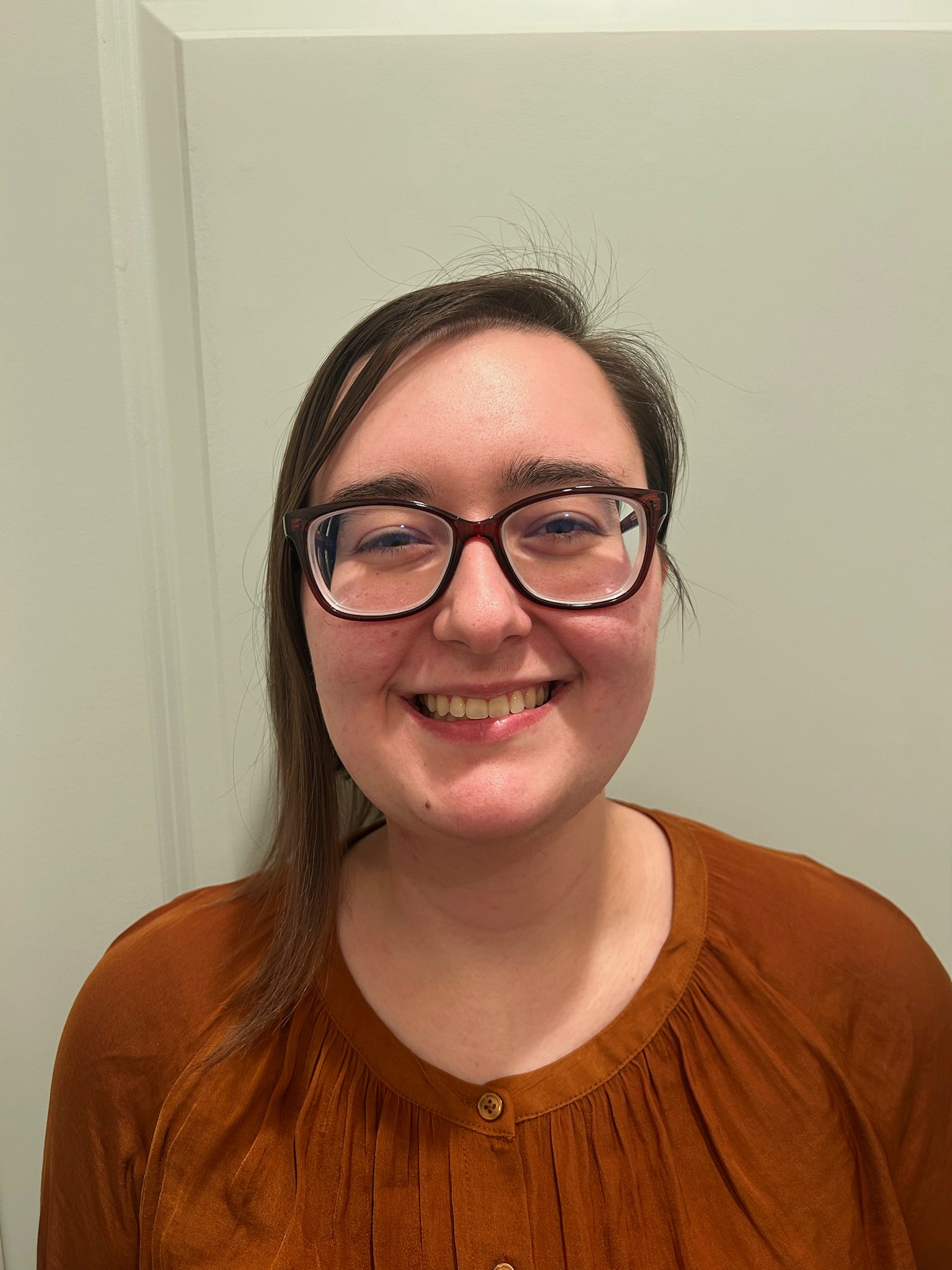
BIO
I'm an transfer student in the UROP program here at FSU. I grew up outside of St. Louis, Missouri and moved to Florida with my family in 2020. After graduating, I hope to pursue further education in Fisheries Science.
Oxygen Supply Capacity of Atlantic Stingray (Hypanus sabinus) and Hardhead Catfish (Ariopsis felis) Across Temperature
Authors: Leith Schieferdecker, Dr. Alyssa AndresStudent Major: Biology
Mentor: Dr. Alyssa Andres
Mentor's Department: FSU Coastal and Marine Laboratory Mentor's College: College of Arts and Sciences Co-Presenters: Brantley Bellamy
Abstract
The climate of the Gulf of Mexico has been warming in recent decades, spurring interest into how this change will impact fish in the region. The Atlantic stingray (Hypanus sabinus) and the hardhead catfish (Ariopsis felis) have ranges which overlap along the Southeastern coast of the U.S. and the gulf. This research aimed to quantify the thermal sensitivity of physiological metrics in these species, such as low oxygen tolerance (Pcrit), oxygen supply capacity (α), and blood oxygen carrying capacity (measured in hematocrit, HCT), known to influence fish performance and viable fish habitat. Fish subjects were exposed to exhaustive exercise and low oxygen over a range of temperatures (20, 26, 30, 34C). Blood samples were taken at each temperature to measure HCT. Direct metabolic rates across a spectrum of activity were then measured via respirometry at each temperature and under declining ambient oxygen. These measures facilitated the calculation of Pcrit and α across temperature. So far, results demonstrate that α and Pcrit increase with temperature in all species, but that Atlantic stingrays demonstrate less temperature sensitivity across metrics. Findings indicate that tolerance to low oxygen is compromised as temperatures rise, with differential sensitivity among species. No significant thermal trend in HCT has been demonstrated, thus the measured increase in α with temperature is likely facilitated by something other than red blood cell volume. These findings are preliminary, and research is still ongoing, but this work offers insight into the robust thermal tolerance of these species in the face of climate change.
Keywords: oxygen, gulf, ocean, fish, stingray
25th annual Undergraduate Research Symposium, April 1, 2025
Karen Pimentel Poster Session 4: 3:00 pm - 4:00 pm/ Poster #91

BIO
I’m a second-semester nursing student at Florida State University with a deep interest in how science can be applied to improve patient care. I’m currently involved in a research project that explores how the wording of clinical case descriptions—neutral versus negative—can influence the stigma nurses may feel toward patients. We use a quantitative descriptive design, asking participants to respond to ten different case vignettes. This study has shown me how powerful language can be in shaping clinical impressions, and it’s given me a better understanding of how to approach patient care with empathy and objectivity.
I’m originally from Miami, Florida, and growing up in such a diverse community helped spark my passion for helping people from all backgrounds. My goal is to become an emergency room nurse, where I can care for a wide variety of patients and think critically under pressure. I love the fast-paced environment and the opportunity to be there for people during some of the most difficult moments in their lives. Nursing is more than a career path for me—it’s a calling to serve, support, and advocate for others when they need it most.
Stigma by Nursing Students’ Towards Clients
Authors: Karen Pimentel, James WhyteStudent Major: Nursing
Mentor: James Whyte
Mentor's Department: Director of PhD in Nursing Science Program Mentor's College: College of Nursing Co-Presenters: Nicolas Monteagudo
Abstract
ntroduction: Nurses clinical impressions are influenced by a variety of factors related to clinical information to which they are exposed.
Purpose: The purpose of the study was to determine the effect of neutrally worded versus negatively worded case descriptions on stigma towards clients.
Method: The study used a quantitative descriptive design wherein participants read and responded to a total of 10 case vignettes. Five vignettes were negatively worded and 5 were neutrally worded.
Results: The results indicate individual differences related to the vignettes with significant differences when case vignettes were negatively worded.
Conclusion: The study indicates significant differences in nursing students impressions depending upon the negative or positive elements of information provided in a clinical setting.
Keywords: Stigma by Nursing Students
25th annual Undergraduate Research Symposium, April 1, 2025
Luisana Pereira Baez Poster Session 3: 1:45 pm - 2:45 pm / Poster #163
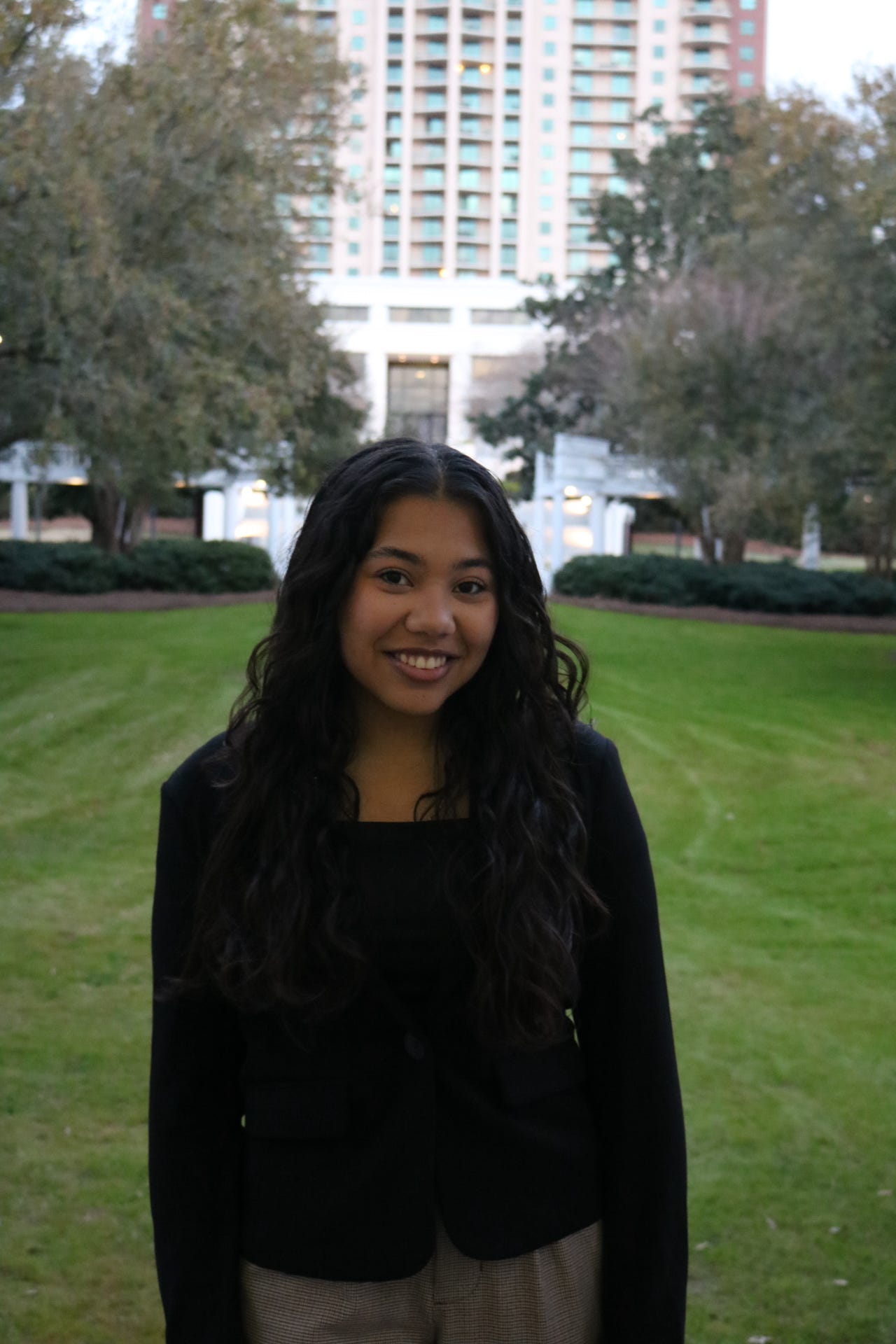
BIO
I am Luisana Pereira Baez, and I am currently studying International Affairs and Political Science. I am interested in working in diplomacy or policy analysis after pursuing a law degree. My research focuses on a data-driven approach to policy creation. I am passionate about the policy creation process and plan to pursue further research during my undergraduate career that will inform this process.
Understanding Assaults on the Police: A Systematic Review on the Strength, Limitations, and Future of National Data Sources for Empirical Research
Authors: Luisana Pereira Baez, Dr. Kellar SheppardStudent Major: International Affairs and Political Science
Mentor: Dr. Kellar Sheppard
Mentor's Department: Criminology and Criminal Justice Mentor's College: College of Criminology and Criminal Justice Co-Presenters: Mariafe Concha
Abstract
Police violence has become a critical public policy issue, yet prior research has noted that there are numerous limitations and gaps in national data sources commonly utilized in this area of research. While there have been concerted efforts to capture national data on crime rates, police use of force, and other key outcomes, problems with national data capturing assaults have persisted. Thus, more work needs to be done understand the current status of national data and its ability to monitor and research assaults on police officers. To this end, this project seeks conduct a systematic review of the literature to address two research questions: What are the most common data sources utilized in quantitative research of police assaults and what are the relative strengths and limitations of each of these data sources? By addressing these questions, this project is designed to not only establish the most common data sources in this research area but evaluate the accuracy, reliability, and comprehensiveness of each source. The study will provide useful recommendations for the improvement of data collection practices by establishing potential biases, gaps, and inconsistencies that could distort perceptions of violence against law enforcement officers. Further, it will illuminate opportunities to improve the state of police assault data and facilitate translational policing research.
Keywords: Assault on Police, Police Use of Force, National Databases
25th annual Undergraduate Research Symposium, April 1, 2025
Bianca Beliard Poster Session 4: 3:00 pm - 4:00 pm/ Poster #37
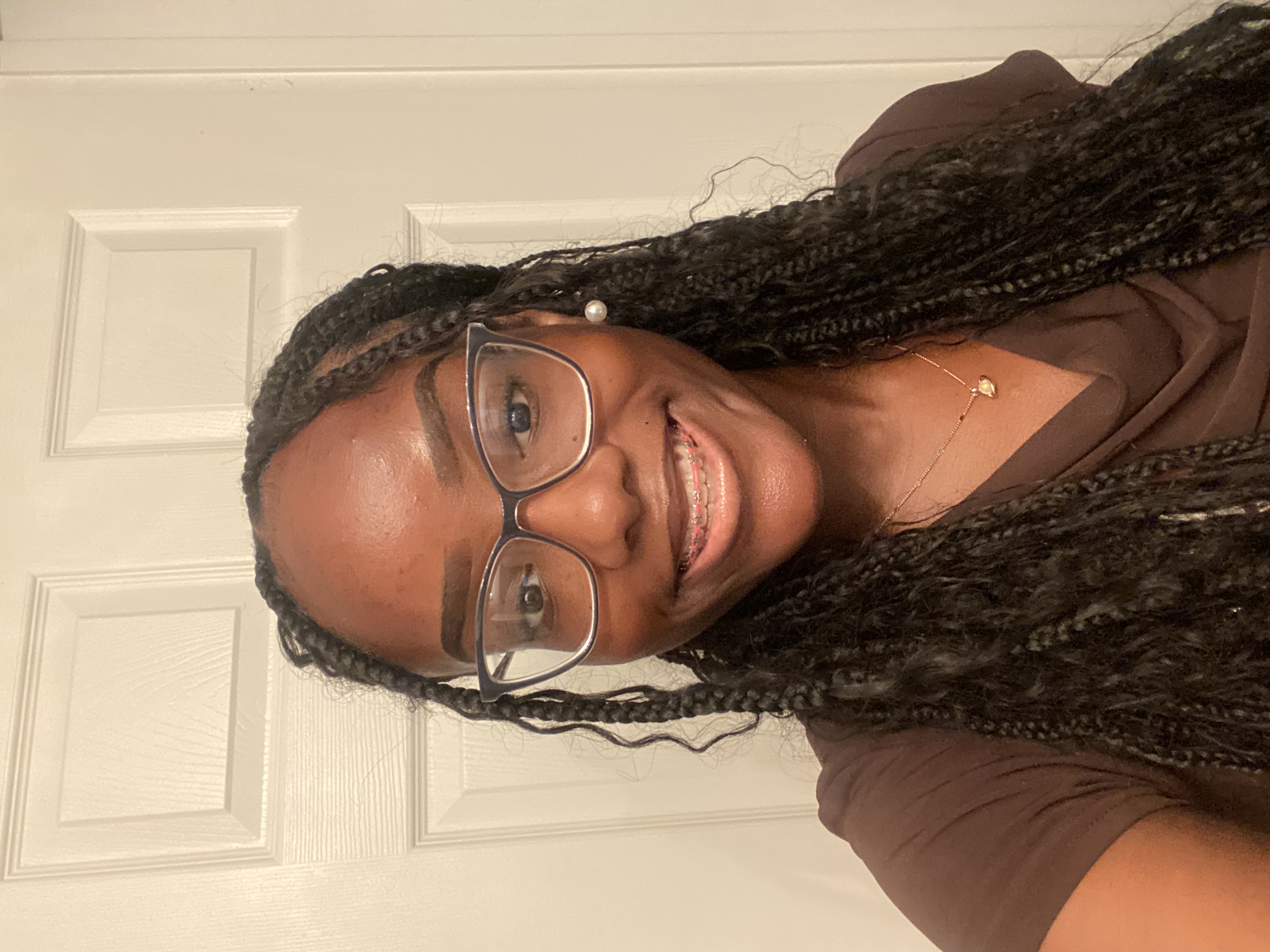
BIO
I am a double major in Criminology and Psychology with a certificate in SAS Programming and Data Analysis from Fort Lauderdale, FL. I aspire to be a Clinical Psychologist to provide culturally evidence-based programs in unfortunate communities. I am interested in doing more studies that deal with the mental health of minorities with interests in forensics.
Risk-Need-Responsivity: Understanding Systemic Barriers and Implementation within Underserved Communities
Authors: Bianca Beliard, Dr. Keller SheppardStudent Major: Criminology and Psychology
Mentor: Dr. Keller Sheppard
Mentor's Department: Criminology Mentor's College: College of Criminology and Criminal Justice Co-Presenters:
Abstract
The juvenile justice and human service organizations provide services to a population with considerable diversity in their social risk factors and most pressing service needs. Increasingly, juvenile justice systems have adopted the Risk-Need-Responsivity model to inform case management and custodial decisions. The Risk Needs Responsivity model is a framework that provides effective treatment to a specific individual. It will ensure that the youth will be matched with a program that addresses their criminogenic needs with proper intervention. However, prior research suggests that there are numerous barriers to implementing many essential components of the RNR model (risk-needs assessment instrument, continuum of care, evidence-based and needs-aligned interventions, etc.). This project seeks to examine the feasibility and fidelity of the RNR model across different systems and communities. To conduct this study, I will interview licensed clinicians and justice officials in different communities to view cultural responsivity to such barriers experienced. Also, I will do field observations of the children in the community to see how well they respond to the treatment. The findings of this study will increase more knowledge of youth in at-risk programs around the world and create an impact of reducing recidivism among youth.
Keywords: Evidence-based programs, Juvenile justice, Risk-Need-Responsivity, and Systematic barriers
25th annual Undergraduate Research Symposium, April 1, 2025
Nicolas Monteagudo Poster Session 4: 3:00 pm - 4:00 pm/ Poster #91
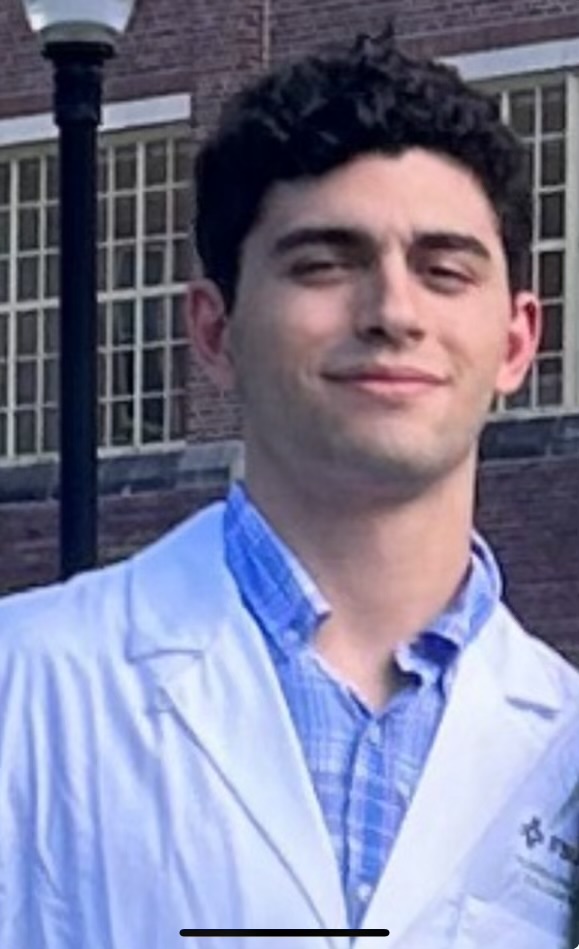
BIO
My name is Nicolas Monteagudo, and I’m a nursing student at Florida State University. My research explores mental health stigma among nursing students, specifically examining how the language used in clinical case descriptions can influence perceptions. The purpose of my study is to determine the effect of neutrally worded versus negatively worded case descriptions on stigma towards clients.
I chose this research because I’m passionate about improving how mental health is addressed in healthcare education. As future nurses, the way we’re trained to perceive and discuss mental health conditions plays a vital role in how we ultimately treat patients. By identifying how subtle language shifts can impact stigma, I hope to help create more empathetic, nonjudgmental clinical environments—starting with nursing education itself.
Stigma by Nursing Students’ Towards Clients: Exploring the Effect of Neutral versus Negative Case Vignettes
Authors: Nicolas Monteagudo, Dr. Jim WhyteStudent Major: Nursing
Mentor: Dr. Jim Whyte
Mentor's Department: Nursing Mentor's College: Nursing Co-Presenters: Karen Pimentel
Abstract
Nurses clinical impressions are influenced by a variety of factors related to clinical information to which they are exposed. The purpose of the study was to determine the effect of neutrally worded versus negatively worded case descriptions on stigma towards clients. The study used a quantitative descriptive design wherein participants read and responded to a total of 10 case vignettes. Five vignettes were negatively worded and 5 were neutrally worded. The results indicate individual differences related to the vignettes with significant differences when case vignettes were negatively worded. The study indicates significant differences in nursing students impressions depending upon the negative or positive elements of information provided in a clinical setting.
Keywords: Stigma, Nursing, HIV
25th annual Undergraduate Research Symposium, April 1, 2025
Alejandra Romero Poster Session 2: 10:45 am - 11:45 am/ Poster #28

BIO
As a current undergraduate student at Florida State majoring in biology, I plan to go to graduate school to pursue a doctorate of physical therapy. Being a first generation Colombian-American working towards this career, I have always been passionate about learning how to apply and instill equity in healthcare.
Social Determinants of Patient Health Literacy
Authors: Alejandra Romero, Carli CuljatStudent Major: Biology
Mentor: Carli Culjat
Mentor's Department: Center of Population Sciences for Health Equity Mentor's College: Nursing Co-Presenters:
Abstract
This study explores the impact of social factors on health literacy, a key determinant of health outcomes. Health literacy influences a person’s ability to navigate healthcare systems and manage their health effectively. By examining how different aspects of a social setting affect health literacy, this research helps identify contributors to low health literacy and potential strategies to address it. Participants were referred by clinicians and were instructed to complete a questionnaire. Data used was from a subsection of a larger study. Descriptive statistics and ANOVA were used to assess differences in responses between groups, which were then divided into four categories of perceived access to care. A p-value threshold of <0.05 was considered significant. The results showed that higher health literacy was associated with better patient-provider communication and the patient’s perceived importance of such communication. Marital status did not significantly affect health literacy. These findings suggest that elements of social environment, such as living situation and the quality of patient-provider interaction, play a crucial role in health literacy. The study underscores the importance of a supportive social network, whether through living status or healthcare communication, in improving health literacy. Further research is needed to explore how a lack of support systems contributes to poor health literacy and to develop targeted interventions to address this issue.
Keywords: Health literacy, social determinants, health equity
25th annual Undergraduate Research Symposium, April 1, 2025
Jessie Tucker Poster Session 4: 3:00 pm - 4:00 pm/ Poster #95
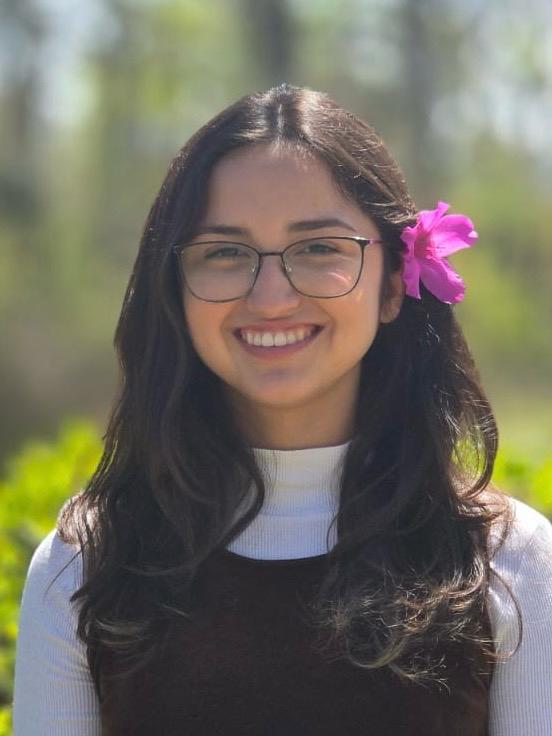
BIO
Jessie is a Behavioral Neuroscience major in the Honors Program at FSU. She is interested in studying and treating neurological disorders, particularly in children. When she graduates, she plans to continue exploring the medical applications of neuroscience research by pursuing an M.D., and hopes to specialize in Pediatric Neurology.
Changes in Goal-Directed Behavior on an Effort Expenditure Task as a Predictor of Anhedonia Symptom Improvement
Authors: Jessie Tucker, Justin RiddleStudent Major: Behavioral Neuroscience
Mentor: Justin Riddle
Mentor's Department: Neuroscience and Psychology Mentor's College: College of Arts and Sciences Co-Presenters:
Abstract
Anhedonia refers to a loss of pleasure. It impacts people’s motivation to complete daily tasks, often affecting populations with major depression. Depression is a growing problem, making symptom research increasingly important. Previous literature correlates anhedonia with reward processing deficits, including decreased goal-directed behavior, or willingness to expend effort for a goal. My project will contribute to research about understanding and treating anhedonia through analyzing its relationship with goal-directed behavior. I will analyze participants with anhedonia from a transcranial alternating current stimulation study at Florida State University. Symptoms are assessed using questionnaires. The two I will analyze are the Snaith-Hamilton Pleasure Scale and Dimensional Anhedonia Rating Scale. Goal-directed behavior will be measured through a computerized effort expenditure task, specifically by the percentage which a participant chooses a higher effort task for a reward. I will compare data from the first and fifth stimulation sessions, and the two-week follow up. I hypothesize that goal-directed behavior change will correlate with symptom change; specifically, participants with increased goal-directed behavior will decrease in symptom severity. To determine the significance of this relationship across sessions, I will use a Pearson’s correlation test. Additionally, I will compare goal-directed behavior changes between responders and non-responders using a Student’s t-test, and hypothesize that responders will show a greater increase in goal-directed behavior. Supporting results for my hypothesis will depict a negative correlation between severity and goal-directed behavior. This would indicate symptom improvement may be predicted and encouraged by increased goal-directed behavior, but would require future research for causal claims.
Keywords: Anhedonia, Effort, Motivation, Reward, Goal-Directed Behavior



